The three passes trek is a route in Nepal straddling several valleys that crosses three passes at 5500m: Kongma La, Cho La, Renjo La. With fantastic views of giants such as Everest, Makalu or the Lhotse, this high altitude route will reward your efforts. In this page, I give you my version of the trek as I walked it. I hope it will make you want to go there too!
If you like the landscape photographs on this page, please take a look at the section Pictures. For example, you can order a mountain poster of my photos, which is a good way to support me ;).
Summary
- A few tips
- Part one: the mid-mountain, going to Namche Bazaar.
- Part two : around Ama Dablam.
- Part three: Gokyo.
- Part four: from Namche to Jiri.
Some tips for the trek of the three passes
A warning: this article on the trek of the three passes is a travelogue and in no way a guide, do not take my itinerary and my stages at face value! However, I can give you some brief advice. If you want more practical information, you can for example consult the pages that I have personally used: romlands, halfwayanywhere, nomadjoseph, triptins. On site, I relied heavily on the excellent book by Cicerone.
Why the trek of the three passes?
I am a fan of the Alps, and I remain convinced that the most beautiful and wildest hikes I have done are in these mountains. Take a look at my section great routes ! If you want to experience the mountains, I encourage you to explore the Alps first. Plus, it's better for the carbon footprint. However, if like me you are beginning to have traveled the Alps up and down and across, then the Himalayas become interesting. The landscapes, the Nepalese, the fauna and flora, and above all the very high mountains with their mythical summits: a world separates them from the Alps. In terms of photography, the air is sensationally pure. I take this opportunity to do some publicity for my section of pictures of nepal !
When to leave?
Two periods are ideal: in spring in March-April, and in autumn in October-November. The whole summer season is difficult to pass due to the monsoon (which tends to overflow into the beginning of October now with climate change). The weather is usually better in the fall, but there are plenty of flowers in the spring
How to get there ?
First you have to go to Kathmandu. Then several solutions are available to you: plane to Lukla airport (which most trekkers do, because it is shorter) or bus/jeep to Jiri or Salleri (allow a full day of travel). It is this second option that I chose, going to Phaplu near Salleri. One can easily book an overnight ride in Kathmandu, for example to where you are staying. Note that a road is under construction to Kharikhola, maybe it will be possible to go by jeep there in the future (I was informed that it was already possible, but that the road was so destroyed that it's really not a recommendable option).
Is it difficult?
The biggest difficulty on the three passes trek is hiking at high altitude, the paths being easy to follow. To prepare for it, you have to acclimatise: from 2500/3000m, sleep every day (in theory) only 300m above the previous night. In practice, it is above all necessary to monitor your physical form and go more or less quickly depending on that. By reading my story, you will see that I tried to go a little too fast, don't do like me ;). If any symptoms of altitude sickness occur, descend immediately.
Is it dangerous to go alone?
In Kathmandu, many Nepalese will try to convince you that you need a guide. Sometimes while lying, I saw one tell me that you needed mountaineering equipment and ropes to do the trek of the three passes, this is completely false. As long as you are a good independent hiker, I think that a guide is really not essential or even not useful. My philosophy is more to find things out on my own and I wouldn't have enjoyed hiking the same way with a guide. The path being very traveled, if you have the slightest problem you can always ask for help (I think I have never spent an hour without seeing someone). See what suits you best.
Do you need crazy gear?
When you hike on the trek of the three passes you see people dressed from head to toe in Arcteryx… I left with my good old Decathlon down jacket and a 15 degree sleeping bag. As there are accommodations every hour of walking and they all offer rooms with very warm blankets, a heavier sleeping bag would have been of no use to me. The only slightly “technical” component that is useful are mini-crampons to pass the small, easy glacier before the Cho La pass. You can buy them at the Kalapatthar shop in Kathmandu (ask where it is, it's well hidden but worth a visit). Another useful component is a water filter, which will allow you to drink tap water without getting sick. I personally bought the Hydrapack filter from Decathlon.
When do we eat?
There are accommodations very regularly along the way. The cooking is almost always homemade, so it takes a bit of time, but the wait is amply rewarded. Among the essentials, there is the Dahl Bat: rice, grilled/boiled vegetables and lentil soup. No two are the same and you're always entitled to a second helping! For lunch, I often took the Sherpa Stew, a good soup with lots of vegetables and pasta.
I invite you to refer to the links I have given if you have more questions about the organization of the trip. You can also contact me using the contact form on the home page and I will answer you with pleasure. On to the story!
The three passes trek solo. Part one: the middle mountain, going to Namche Bazaar.
First day. Bad impressions in Kathmandu.
Arrival in the capital
I take a flight from Dubai then Kathmandu. You can admire the power of oil in Dubai and its fountains in the middle of the desert. First view of the Himalayas from an airplane: you say to yourself "wow, this is Everest", and then you discover five minutes later that there is a whole row of even higher peaks some distance away, and another and one more... It's infinite and immense...
The visa is done in 10 minutes and 54 euros. Assailed by taxis at the exit of the airport, I still managed to get the bus stop indicated to me. A friendly cow licks my backpack while I wait. I don't understand what's going on: dozens of buses pass by, the doorman shouts something and if no one waves the bus leaves just as abruptly. As I can't figure out which bus to take, I get on a scooter which takes me to Thamel for 150 rupees. Obviously without a helmet. The highway code is non-existent or incomprehensible. The air pollution makes me cry on the scooter.
Various requests
In Thamel, I am assailed from all sides by people wanting to sell me one thing or the other. It's beautiful but no way to stay quiet for 5 minutes. I buy a nice painting 3000 rupees. They explain to me many times the principle of the mantras and they show me all the temples of the city. “Good karma, we must give for anything received”. This does not prevent the other from asking me for 4000 rupees when I give him 500 for the guided tour he gave me… The Kalapatthar shop is worth the detour: we make our way through a compact crowd to find a type who sits on a pile of trekking equipment and who negotiates better… Small crampons bought 700 rupees. No bus to Phaplu unfortunately, everyone tells me it doesn't exist anymore. I rent a jeep from the hostel for 2800 rupees.
Second day. A useful jeep.
+ 700m / – 500m 11km
Rise at dawn
Departure by jeep at 4:30 a.m. with an Australian, a Canadian, two Nepalese and a French couple. On the way to the three passes trek! During the trip, I discovered:
- Why only jeeps go to Phaplu, and not buses
- That there are rivers with a bed so wide that it scares the hell out of you
- That you shouldn't even try "slightly spicy" dishes
- That there are French people who have spent their lives traveling to the four corners of the world, who are going for the fifth time to the Himalayas on the trek of the three passes, but who do not even know what the Appenines are and rarely go in the Alps
- That we can fit four in a back seat without a problem
- That Nepalese music can be very very (very) repetitive
First impressions
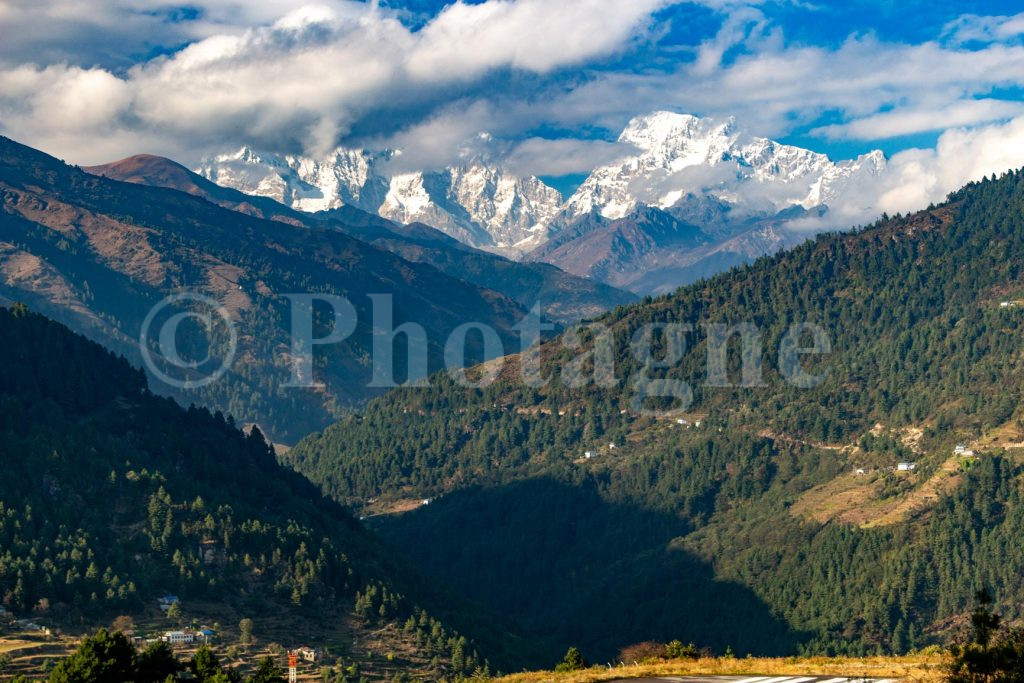
The first view of the Himalayas is incredible, the peaks seem to hover in the sky because they are so high. I leave my jeep companions in Phaplu and walk a little in the evening to reach Ringmu. The change of scenery begins and I tell myself that this trek of the three passes will really be an extraordinary journey: postcard landscape, Nepalese on the trails with big baskets on their backs, sun setting over mountains that I naively take for 8000 but which are “only” 6000-7000…
I stop at the first hostel I find in Ringmu at nightfall, this will be my most “authentic” stop on the trip: I am lodged with the grandfather in a back room where the milk is curdled. I chat with two Nepalese who also stopped there. They too go on a trek, I foolishly thought it was an activity reserved for wealthy foreign tourists like me who have time to waste! The Dahl Bat is more than enough, with slices of carrots freshly picked from the garden which are very tasty. I pay 1000 NPR for the meal and the night. At the time I feel like I'm being ripped off (the two Nepalese didn't even seem to pay), but in fact it will be my lightest bill on the course.
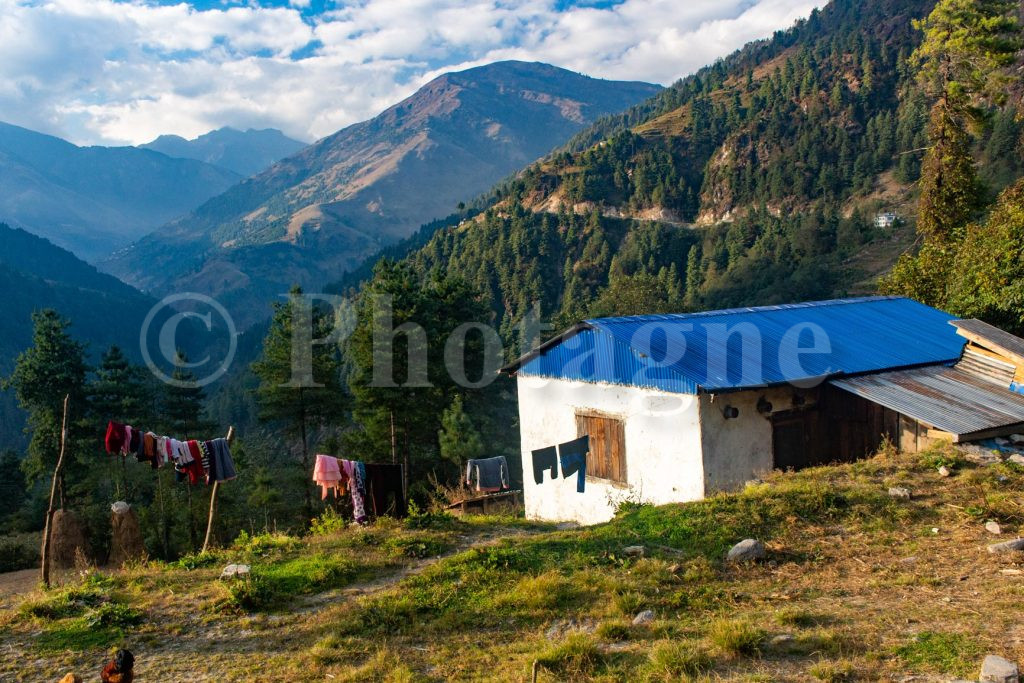
Third day. An idyllic valley.
+ 1650m / – 1800m 19km
Silence is golden
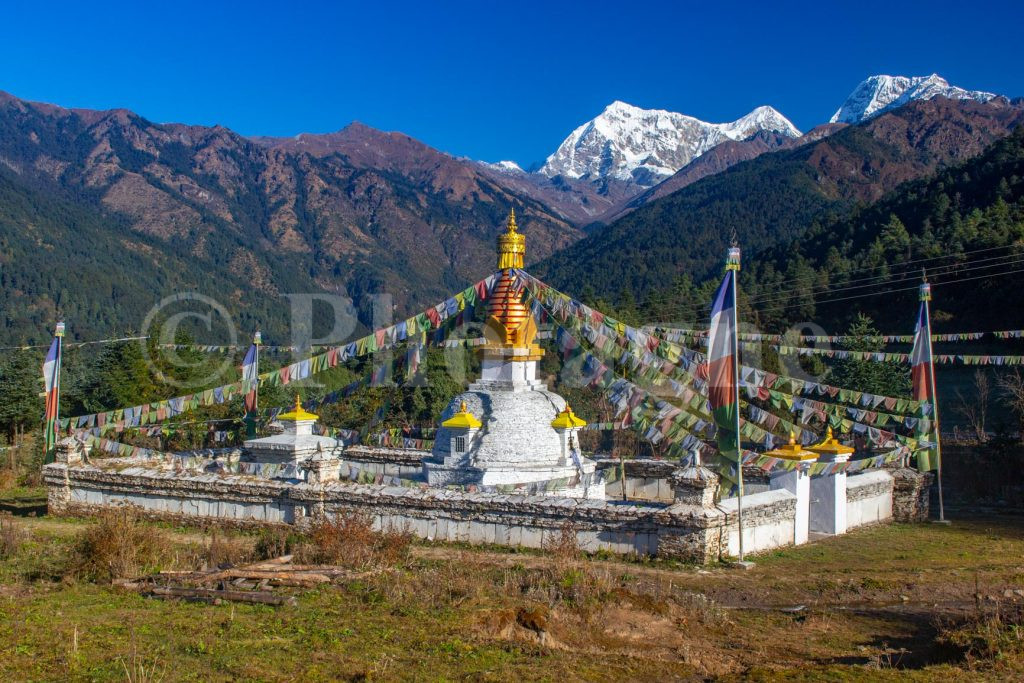
Leaving at 7am, fresh air, it froze. Above all, it is the silence that strikes! No engine or plane noise like there is always in the Alps… The sky is incredibly clear, the glaciers shine. Crossing a "small" pass at 3000m. Superb descent from village to village, the vegetation becomes tropical, I arrive in what I take for rice fields (in fact I will learn later that it is millet that they grow here). I take chapatis because I think it's a side dish. In fact they are sweet, but the flour has a taste! Which disappeared a long time ago with our too sifted flours. I also try the Sherpa stew, this vegetable soup (carrots, potatoes, cabbage…) and pasta is a must, it will become my favorite lunch menu.
Tropical atmosphere
I cross the first suspension bridge, it is all metal, far from the naive idea of rickety rope bridges. The ascent in the heat is difficult… But it's superb, the atmosphere reminds me of Hawaii. There are lots of plants that I don't know at all. I see almost only Nepalese on the trails, hardly any foreigners. Children are curious and cute. The valleys are immense, the eye finds it difficult to measure them, but the feet do. It's idyllic, it looks like life is good in these colorful houses, everyone is smiling. The gardens of the houses are real gems, maintained to the millimeter and very flowery. I was not expecting this “beautiful life in the mountains” aspect!
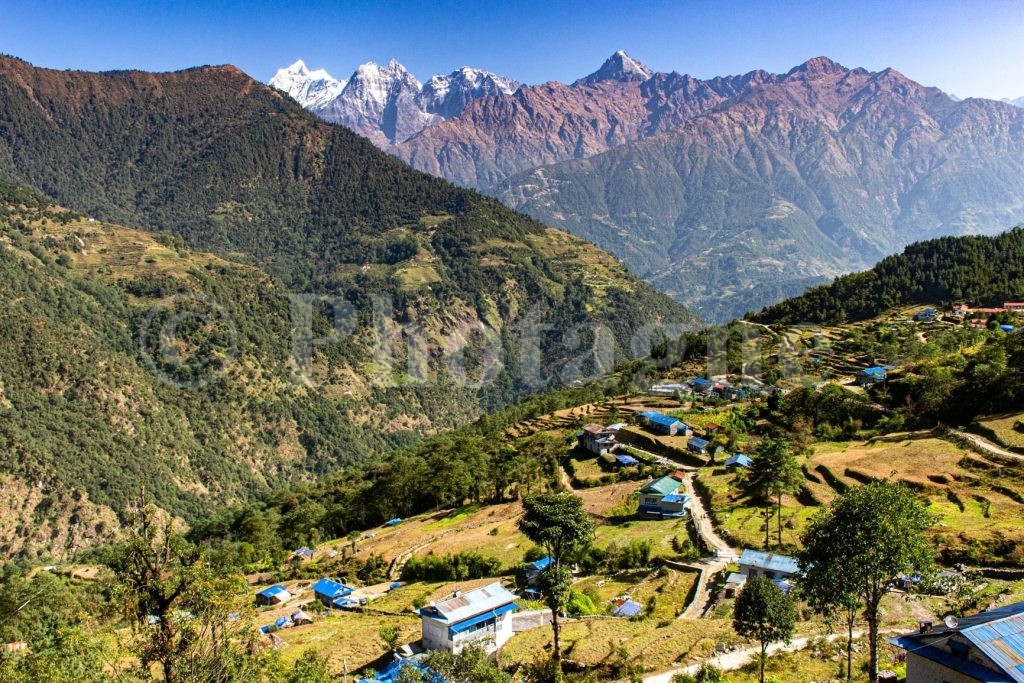
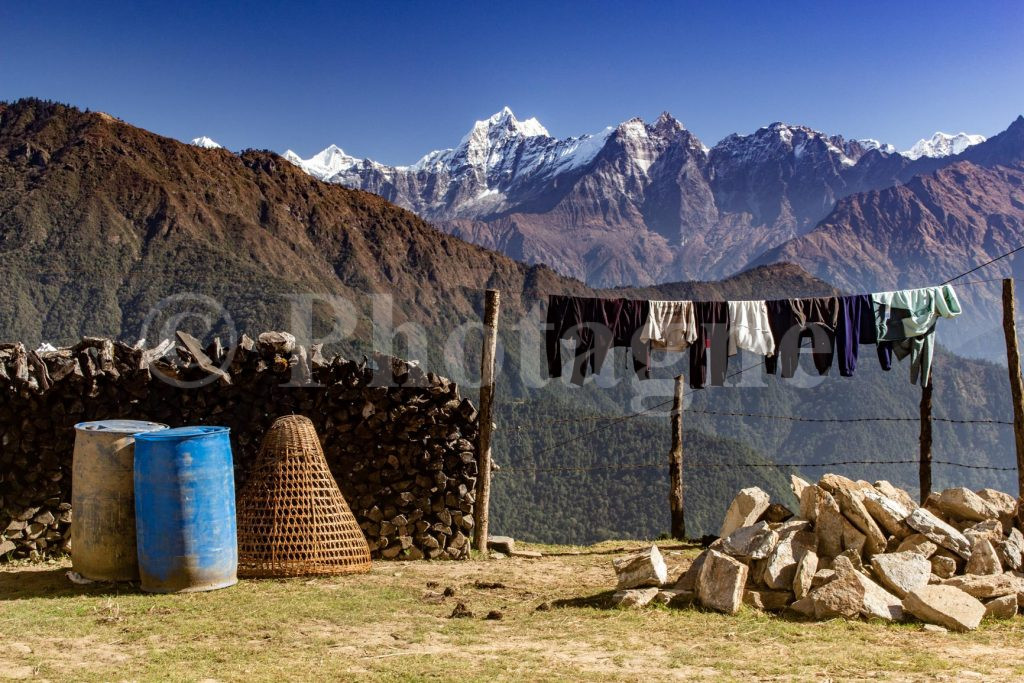
I pass a small monastery at a pass: you have to turn clockwise. The village of Kharikhola is very lively, for the first time I meet a lot of foreigners. A bazaar sells pots and various kitchen items… I continue to the hamlet of Kanre where I stop at the only open lodge. It's a little more "hotel" than before: I have a room with 2 beds all to myself. In fact this is the norm on the route of the three passes trek, I didn't expect it, I thought I would stay in a dormitory. But I'm alone tonight. The village is very quiet, not a sound. I eat fried rice with cheese (meh) and an omelette (yum). And the eternal chai…
Fourth day. Arrival on the highway
+ 1700m / – 1550m 23km
Meeting with the carriers
I get up at 7:15 a.m., I overslept! A cool climb through a beautiful forest. I follow a road that is neither marked on the map nor indicated in the guide to the Three Passes trek; it must be brand new. I pass the first porters further on: what a mass of luggage! We hear a hen in the middle, but we don't see it... Further on, donkeys, which I will encounter in large numbers throughout the day. Their hooves are slippery on the wet rock. The Sherpas "encourage" them with a stick, sometimes a little violently. They are also very good at throwing stones at the rump of a recalcitrant animal that is out of reach of the stick.
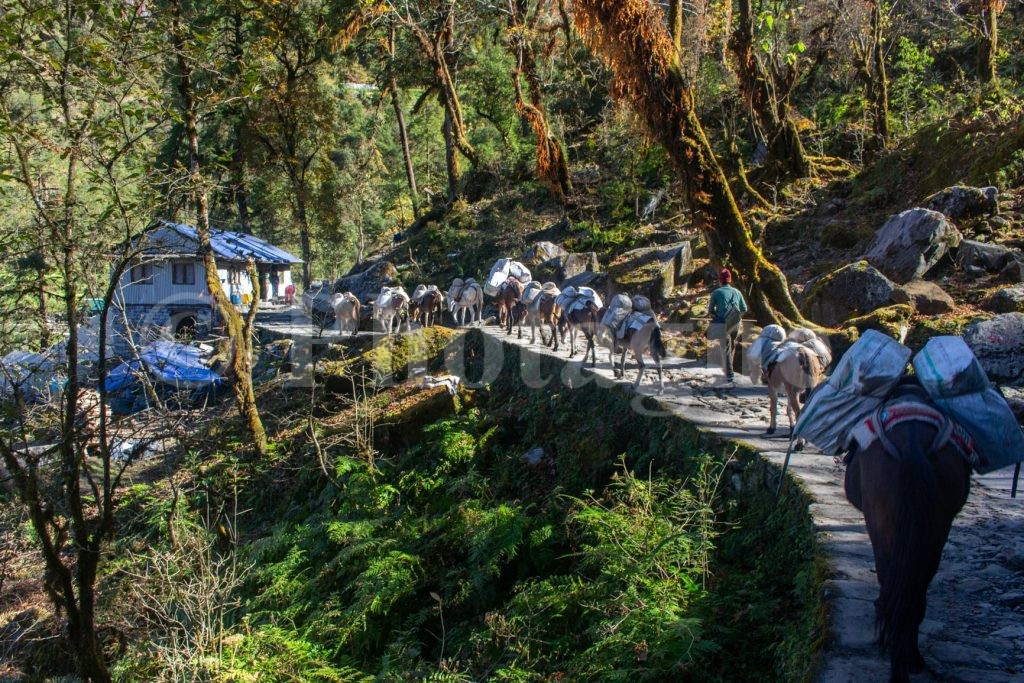
A fantastic Dahl Bat
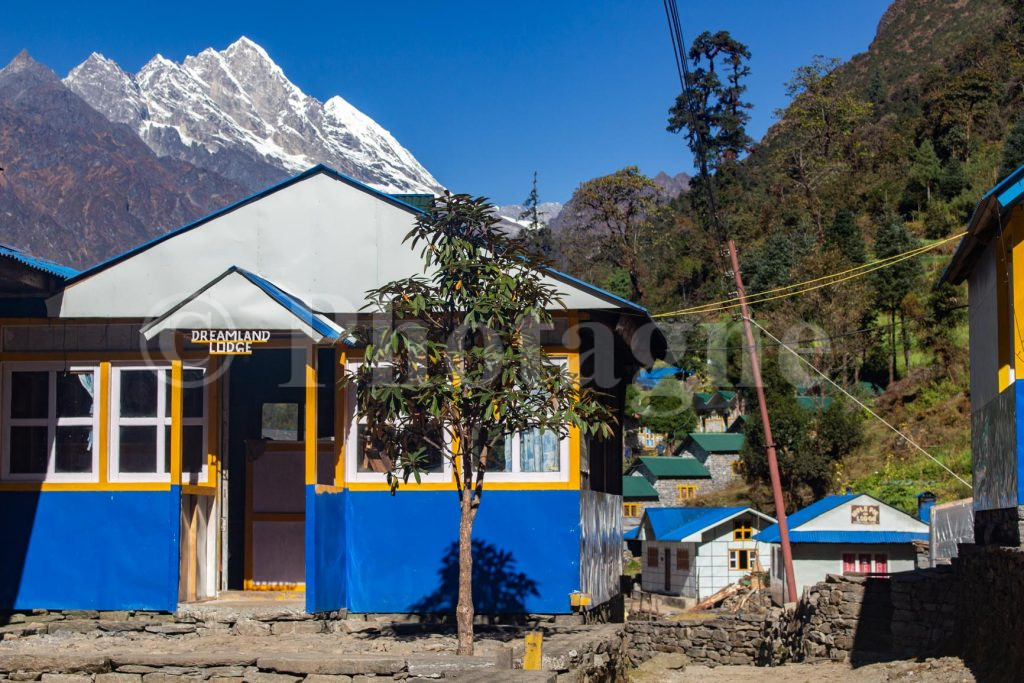
The traffic on the road is multiplied by 100 in the morning, by 1000 in the afternoon after the intersection for Lukla. It's up and down all the time, it's tiring. The kids walk at a speed... For lunch, I stop at a restaurant where a grandmother is all alone serving. It's lucky, I'm the only customer. The grandmother goes to pick fresh herbs and vegetables, takes 30 minutes to prepare the Dahl bat, it's excellent. Then she sits down and quietly watches YouTube videos... Culture shock. The Nepalese walk on the paths with their phones in hand, to listen to songs or to make calls while guiding their donkeys or yaks.
The villages after Lukla are truly packed with tourists on their way to Everest Base Camp, I continue to Bangkar. I'm charged an obscure 2000 NPR entrance fee. Nice lodge (stove lit for the first time, and it feels good!), crazy view of a peak that must be Kusum Kangguru. I'm not the only foreigner there for the first time, there's also an Argentinian who wants to do Kalapatthar and the Three Passes trek. I try the Momo, a kind of Nepalese national dumpling: it's excellent, but not enough.
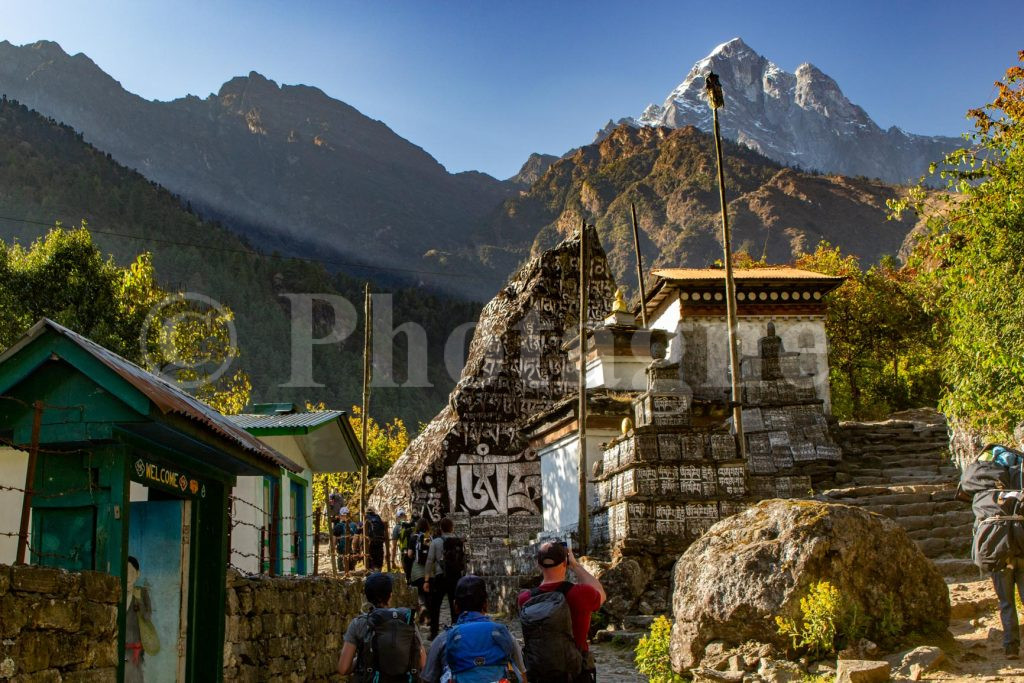
Fifth day. Arrival at high altitude.
+ 1800m / – 900m 16km
Tourists and porters
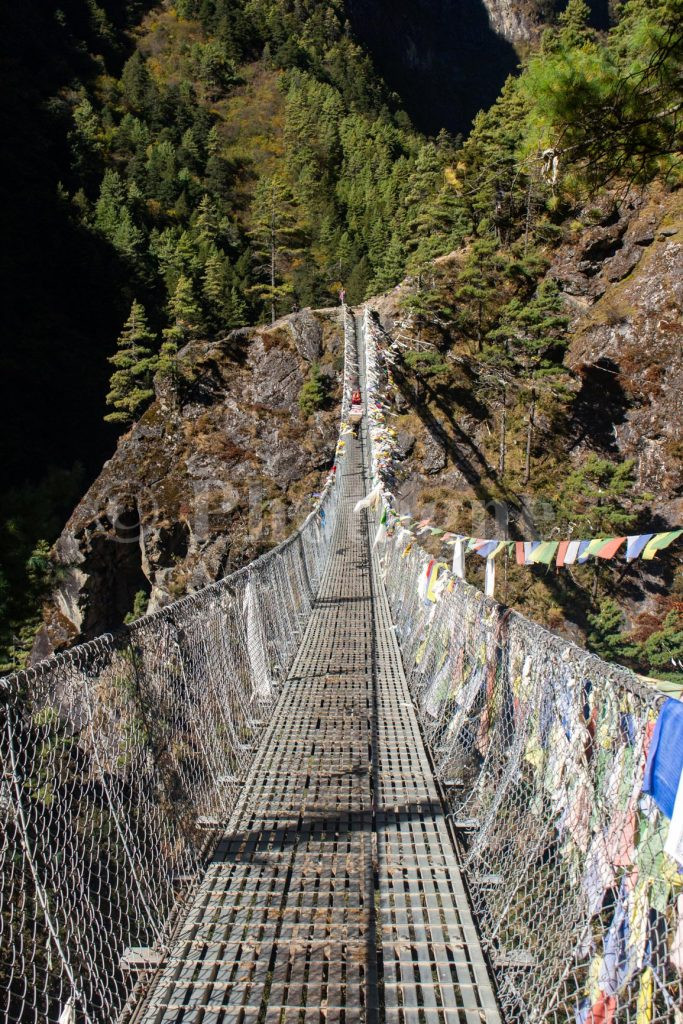
I try breakfast (pancake + tsampa porridge, which is made with local flour), it fills me up but I leave after 8am. We set off in the middle of the fields, we are still in well-inhabited villages. The path is empty at first but gradually fills up. So many porters with huge bags followed by tourists with fanny packs… It breaks my heart, I would like to see them carrying their equipment, they would take less unnecessary things. Other porters carry goods for the refuges on the three passes trek, one of them tells us he carries 90kg, it's just unimaginable. They have an ingenious system for carrying that rests on the head, this must allow the weight to be distributed well on the spine.
I enter Sargamatha National Park, 3000NPR. It gets much wilder: I walk through a beautiful valley filled with pine trees with a big, gurgling torrent. I cross some impressive suspension bridges. I stupidly left the key to my Kathmandu hotel in my pocket, I give it to a Dutchman to take back there (in fact he never does, I'll end up paying for a repair for the poor guy from the hotel who didn't have a duplicate). The climb is very beautiful among the pine trees, but there is a lot of traffic. I pass the checkpoint for the national park permit, the guy seems to be new, he takes 15 minutes to swipe a card on a reader.
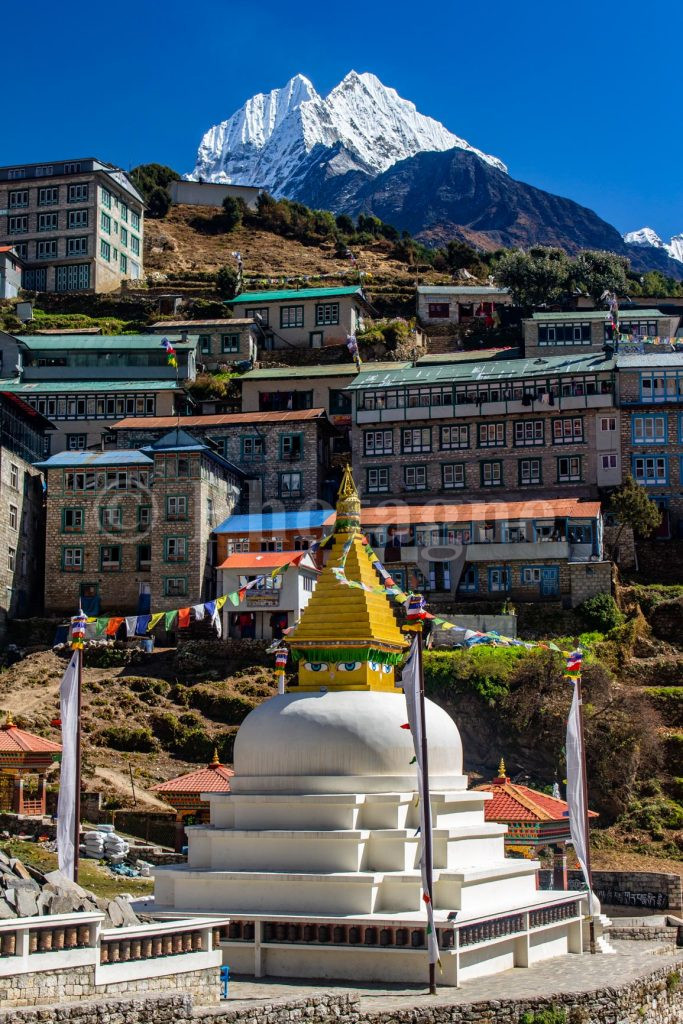
Namche Bazaar
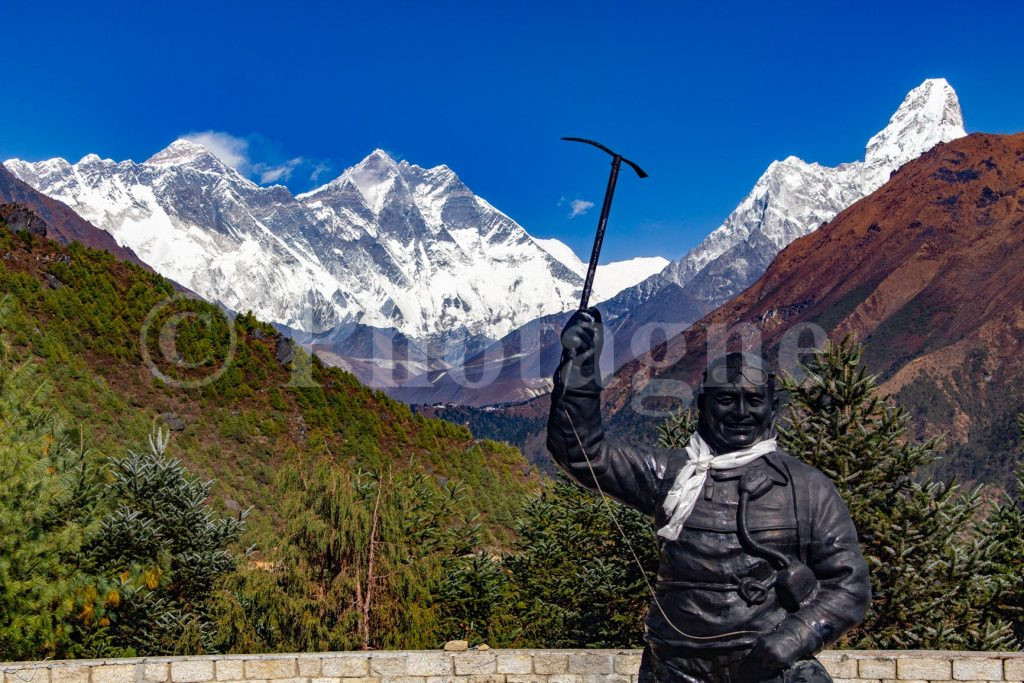
I arrive at Namche Bazaar, strangely the town is empty, I must be ahead of the wave of tourists. The bazaar vendors are idle. I really like the atmosphere of this city which stands proudly facing the mountains, flags fluttering in the wind... The altitude is felt and the town is full of stairs... But what a panorama! It's the first time I've had a view of quite a few peaks at once. Meal in a very comfortable restaurant. Then I go to the Everest viewpoint, with the statue of Tenzing Norgay, and there... Fantastic. It brings tears to my eyes. The most impressive is Ama Dablam: the Matterhorn can go get dressed next door.
I continue on a long, very easy and panoramic path, skipping the recommended acclimatization stop in Namche since I'm in good shape. In Senasa, I decide to continue to Phortse since my legs are still working and I'm not feeling the effects of the altitude too much. So I won't go through Pangboche, which is the "classic" trail of the three passes trek, but by the path just opposite. The next day will prove to me that I made the right choice.
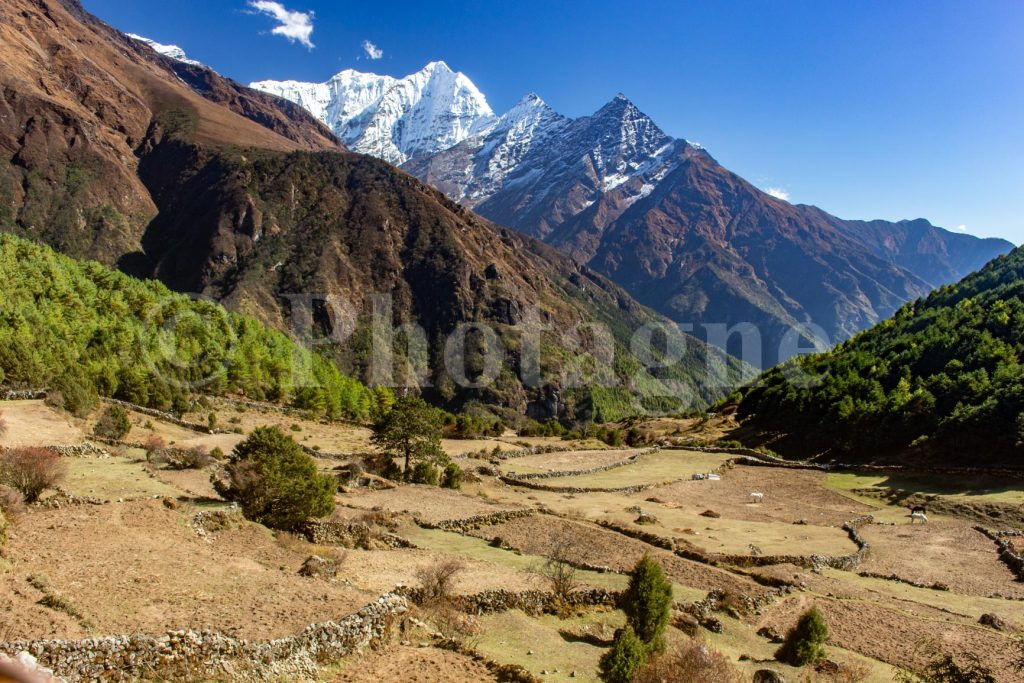
Evening lights
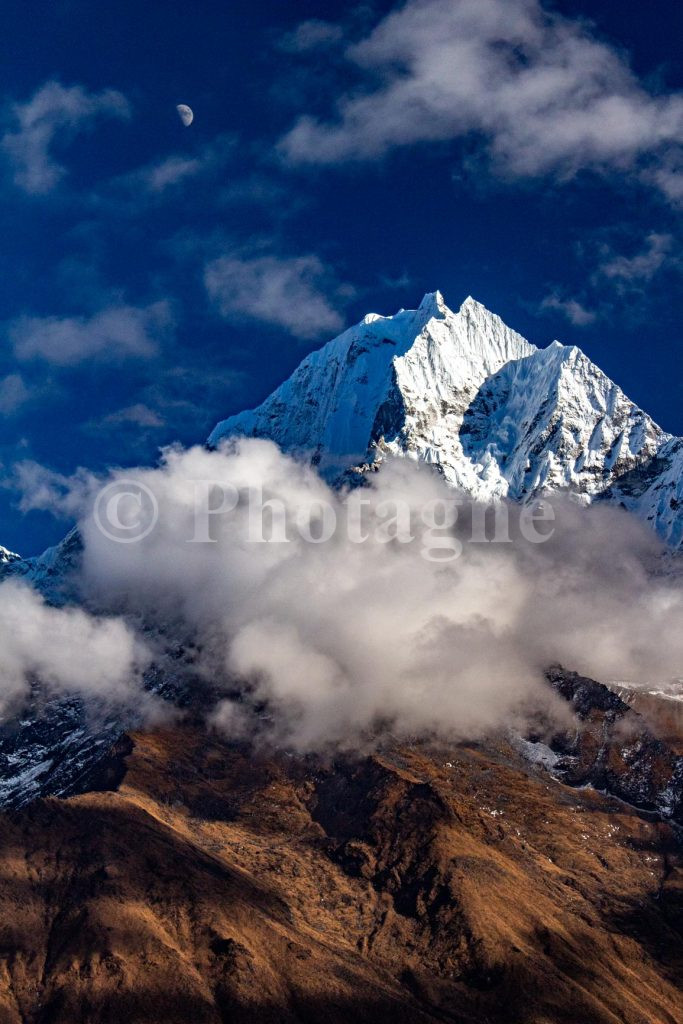
After 3 p.m., there is no one left on the trails: how stupid people are! At this hour the lights are magnificent and I have a sensational view of the summits with the moon. The vegetation becomes higher. I pass another "small" pass at 4000m. In the descent, I meet the local ibex (or Himalayan tahr): the male is huge, it's impressive. I stop at Phortse Tanga because the place inspires me: a small cabin that smokes in the middle of the pines, not far from a torrent that roars into the gorges. The vegetation seems winter for the first time, the trees on the North face no longer have leaves. Bon Dahl beats being reserved in abundance of course, very cozy and well-heated room, it's rare.
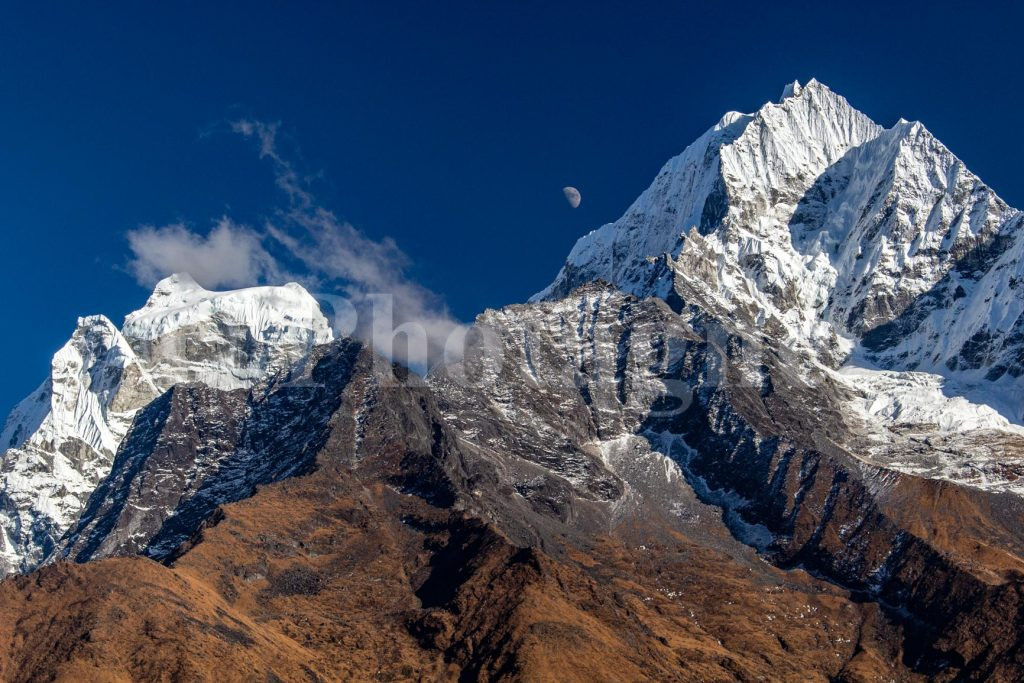
The three passes trek solo. Part two: around Ama Dablam.
Sixth day. On the usefulness of acclimatization.
+ 1650m / – 1250m 13km
Encounter with local wildlife
Departure at 7am with a good pancake in the stomach. It is very cold, the ground is completely frozen. On the way up, I come across a fearless little spotted ungulate, which turns out to be a Himalayan musk deer. Then it's the festival: I see the ungulate a second time, yaks and especially the Himalayan monal, the magnificent emblematic bird of Nepal! It's bright blue, it's so beautiful. (Question: a monal, monals?). A monk passes muttering prayers in the stillness of the frozen air. The village of Phortse is very beautiful at sunrise. Yaks running in the streets...
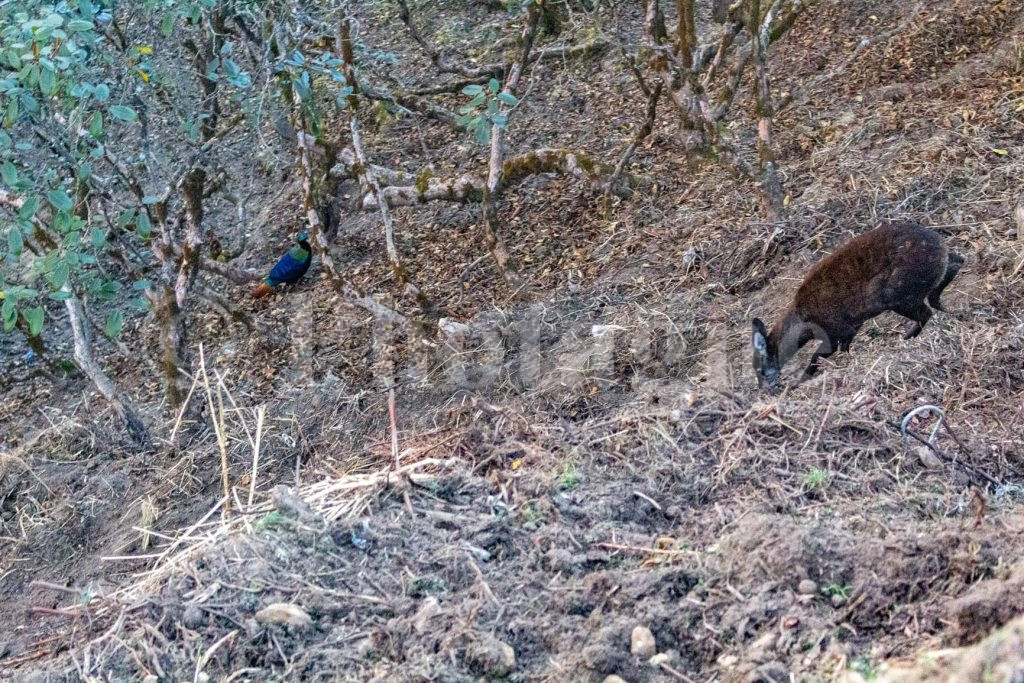
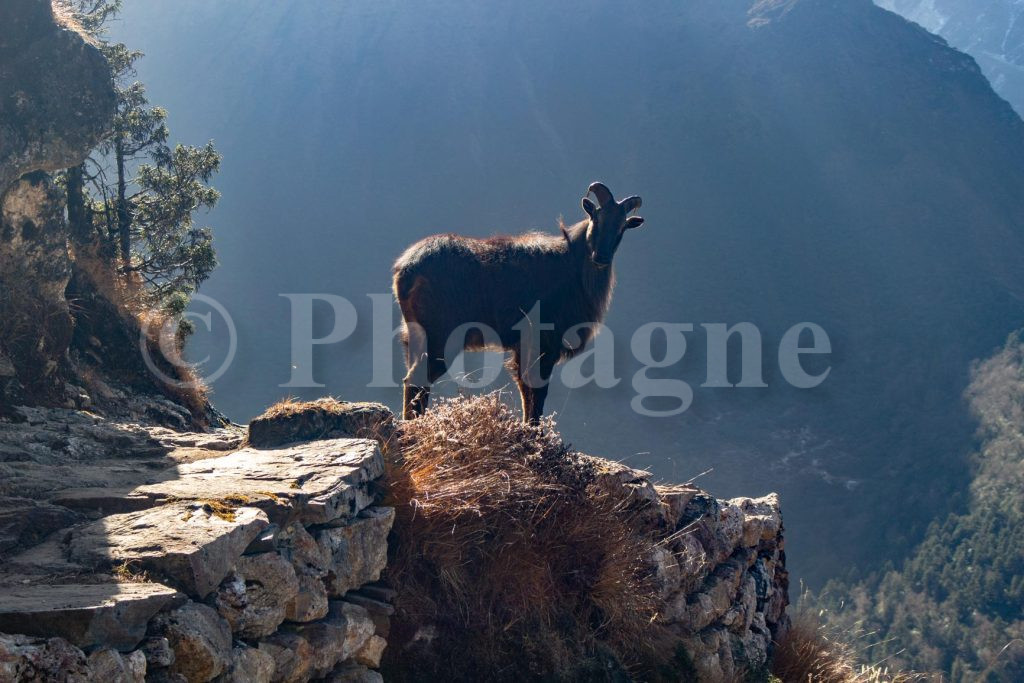
Then it's a portion more or less on the side to reach Pangboche, very panoramic. I meet the tahrs again. There are no more trees, but only altitude vegetation. Arrived at Pangboche around 10:30 am, I eat a Sherpa Stew in the lodge opposite the temple. The atmosphere is not great, all the Nepalese pretend to ignore me.
Wanting to go too fast...
I take a room and go for a walk up along the torrent to see how high I can go. I tell myself that it will be a good training for the trek of the three passes. I reach a flag, walking becomes more and more difficult, I will never reach the small summit planned at 5200m… I come across a herd of quiet tahrs at 5000m, while I can barely put a foot in front the other. In the distance, a Sherpa is carrying a huge bag… incredible.
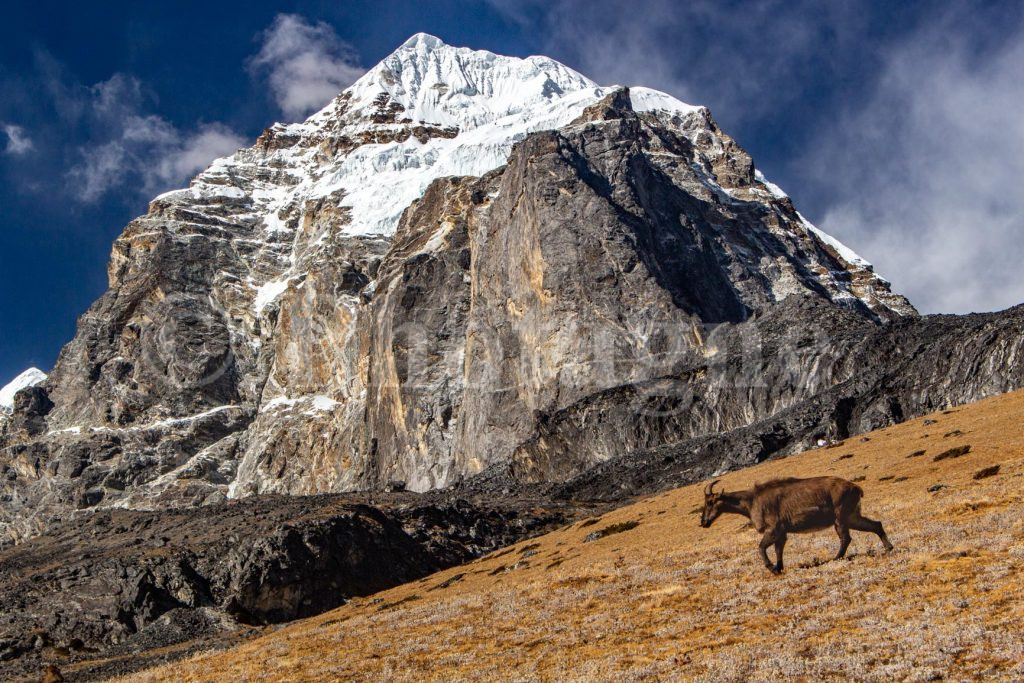
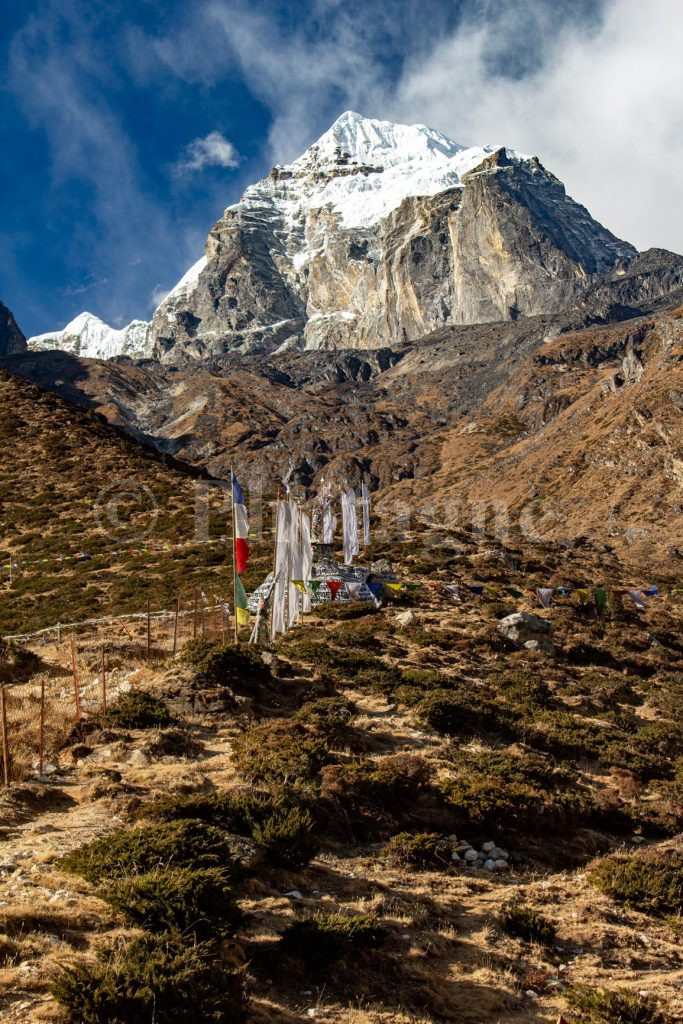
Suddenly I become weak, my head is spinning, as if I was going to pass out. I come down immediately. I'm breathing heavily and feel bad, I can't move my hands. Fortunately in 15 minutes I find myself much lower and it's better. I don't think it was altitude sickness, just discomfort due to lack of oxygen… The most surprising thing is that it happened all of a sudden, without warning. I wanted to do too much: with a little more acclimatization, it won't happen again.
I take some nice pictures in the village in the evening. In the refuge, after dark, no lights and no stove on… I tell myself that things are definitely going to be very spartan, but finally at 5.45 am everything is sorted out. the only tourist, I kind of feel like the intruder in the family, it's unpleasant. I stay until 8 p.m. listening to them talk while ignoring me, then I go to bed.
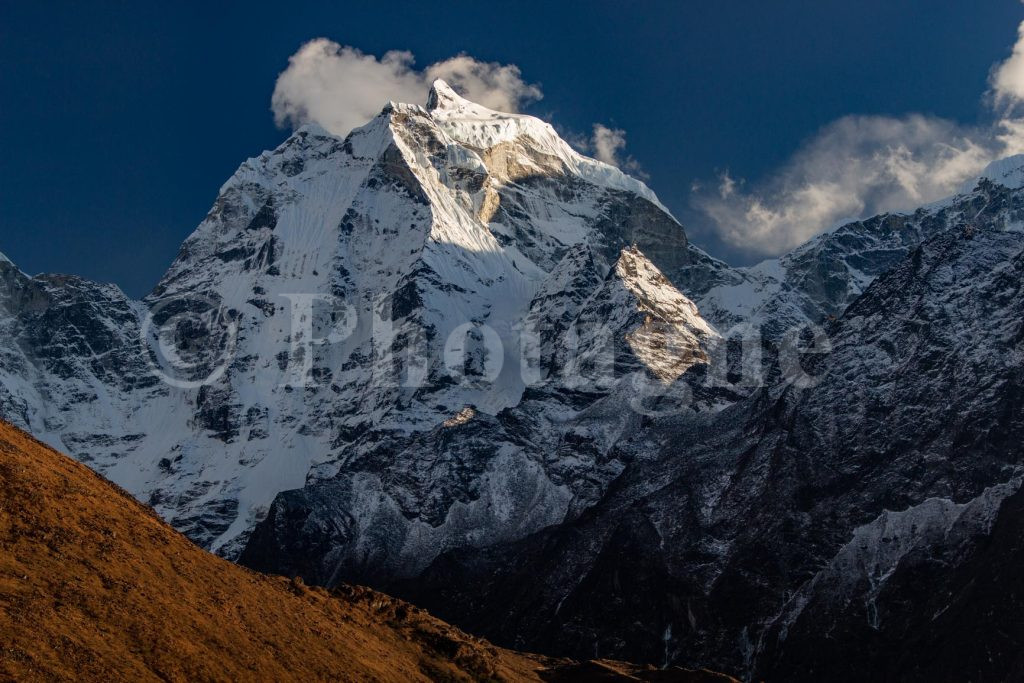

Seventh day. Ama Dablam base camp.
+ 1450m / – 1150m 18km
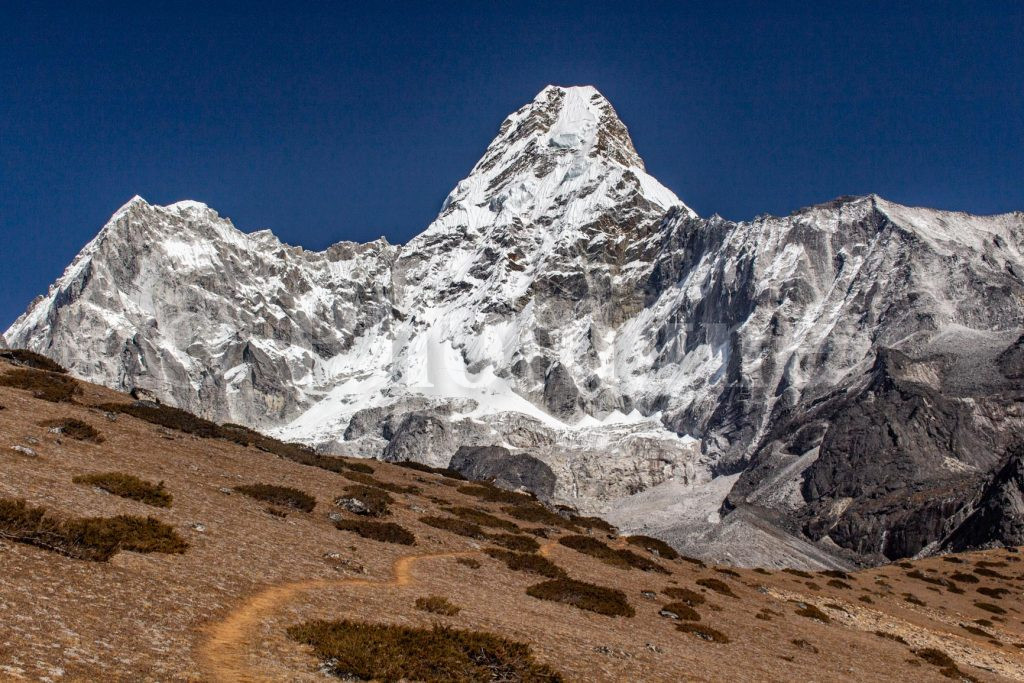
In the morning at 7 am there is no one, whereas my hosts had told me to prepare breakfast at 6:30 am… This place is definitely not very recommendable. I leave, leaving them the money on the table. Breakfast toast + omelette + potatoes in the lower part of the village, very good. Departure for the base camp of Ama Dablam: we cross a torrent with an impressive bed, then we climb gently in what looks like bucolic mountain pastures. I have magnificent views of lots of big peaks whose names I have a hard time remembering. I never tire of admiring Ama Dablam: I think it's the most beautiful peak I know. It reminds me of the Matterhorn.
High altitude experiences
I arrive at the base camp after a small stream. It's a real city: there are between 100 and 200 tents. From afar, you can smell the incense they must be burning there. I continue on the ridge to reach a viewpoint at 5000m. Breathing again becomes very difficult, but I learned from my experience the day before: I only use my muscles at a fraction of their capacity, there is not enough oxygen for sustained effort. I reach 5000m but my head is spinning a bit. I still have time to take a picture of the panorama before descending: it's superb, we are really surrounded by peaks over 6000m.
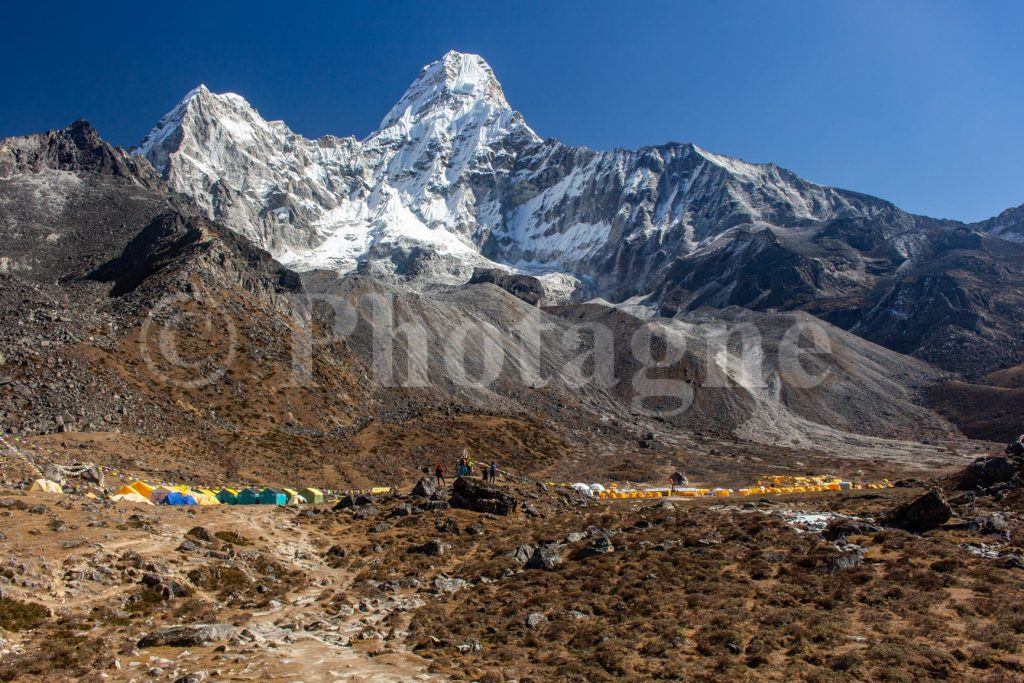
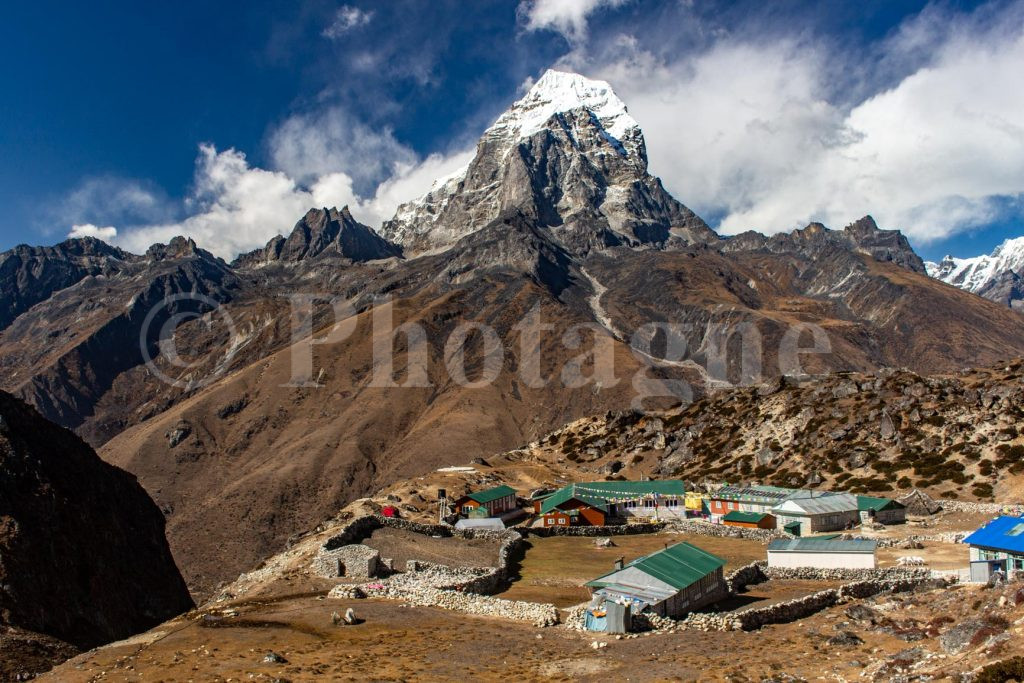
The descent is fast, I take a simple soup at the base camp refuge and very good cake. There is a path that seems to be a shortcut for Dingboche but on the advice of a guide I don't take it: too many stones falling, he tells me. So I do a whole round trip with a lot of elevation and I start to curse the guide seeing from opposite that the path looks quite passable. But further I realize that he was right: the other way must either cross a big torrent of glacier not nice, or pass a big moraine in the uninviting air. I end the day by going to Dingboche by a plan-plan path with breathtaking views, especially with the incredible colors of the end of the day.
A friendly lodge
In Dingboche, the lodge is by far the most comfortable and best heated I've had (first time that my feet haven't frozen in the living room, and I even fall off my sweater!). Very nice atmosphere, welcoming people, however it's packed with people. There is a spittoon at the end of the room and the Nepalese use it! Lemon tea has become my favorite drink, I drink a whole thermos of it. I must have drunk 4-5L of water today. I don't really feel the 4300m altitude, a slight discomfort in breathing perhaps. In the room, people order spaghetti and pizza: WTF. I play cards with a very friendly and multicultural group (US-Brazil-Israel) who are also on the three passes trek. The meal is not very good.
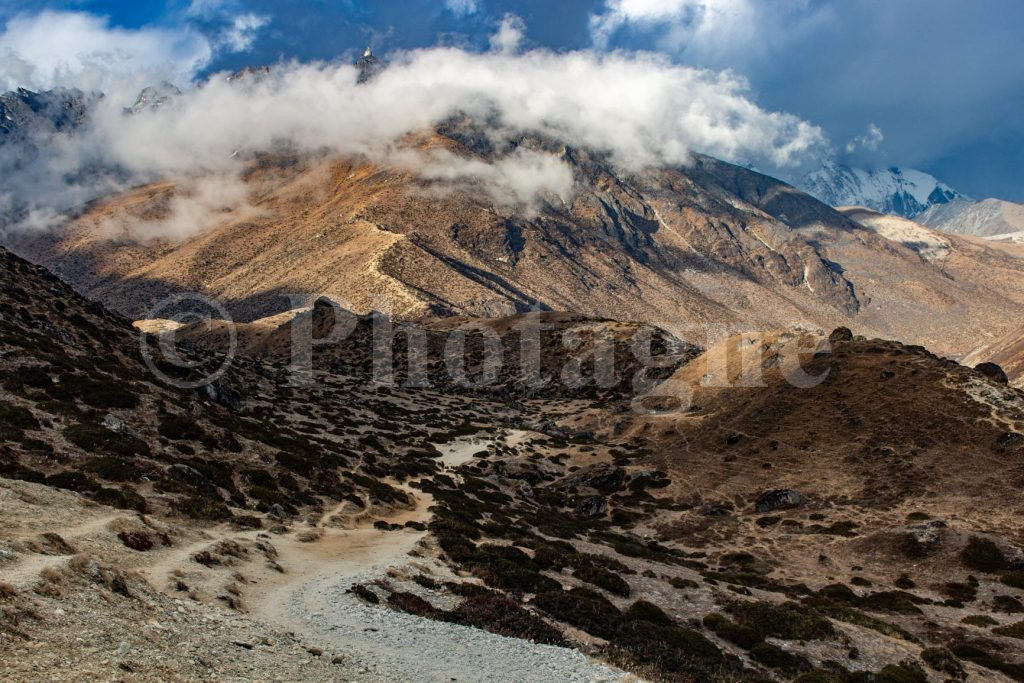
Eighth day. The effects of altitude.
+ 900m / – 900m 9km
A short day
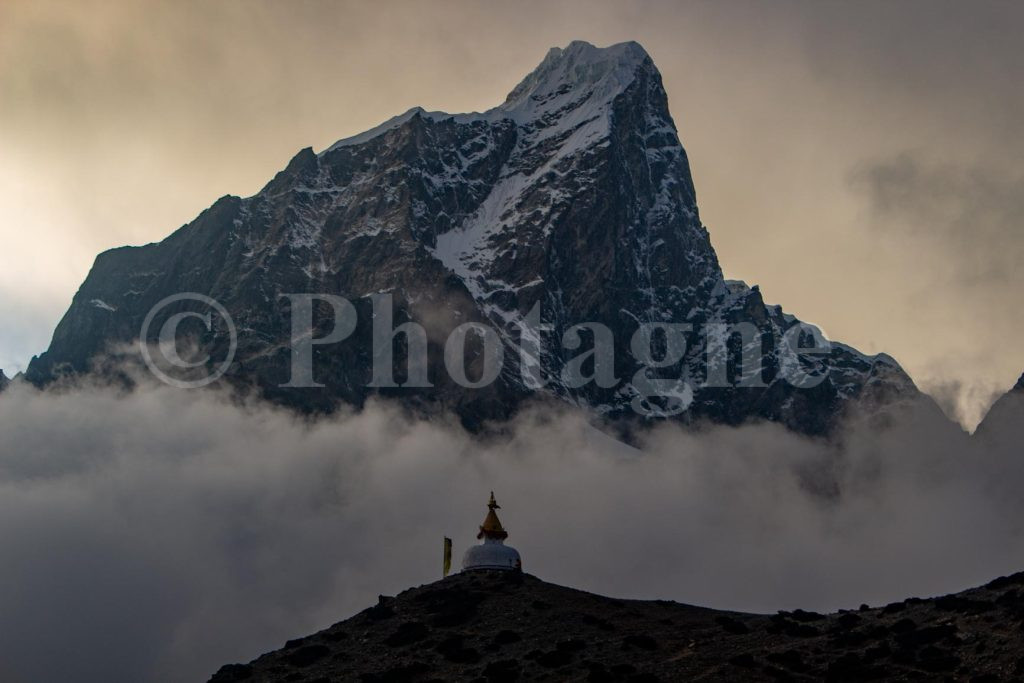
I start at 7am after a really not very good breakfast to go to Nangkartshang peak (5089m). Nice climb at sunrise. We have the impression of rising in space, the air is so clear… Near the top I find this feeling of being like a fish out of water. I try to breathe but nothing comes in. I don't do the last meters, too bad, but the warning of the ants in my hands like the other day is enough. I'm starting to worry about the 5500 for the first pass of the three passes trek, since I can't even manage to exceed 5100. I probably wanted to go too fast in my acclimatization… The three passes trek will have he right of me?
I have a meal in Dingboche in a restaurant that seems to mainly serve Nepalese: they look at me strangely when I come back. The samosa is too spicy for my taste and the soup way too salty. I then continue to Chukhung. It's pretty but I suddenly feel very tired and the sun is beating down, as if it wanted to split my skull open… I decide to turn around and sleep in Dingboche, it's safer.
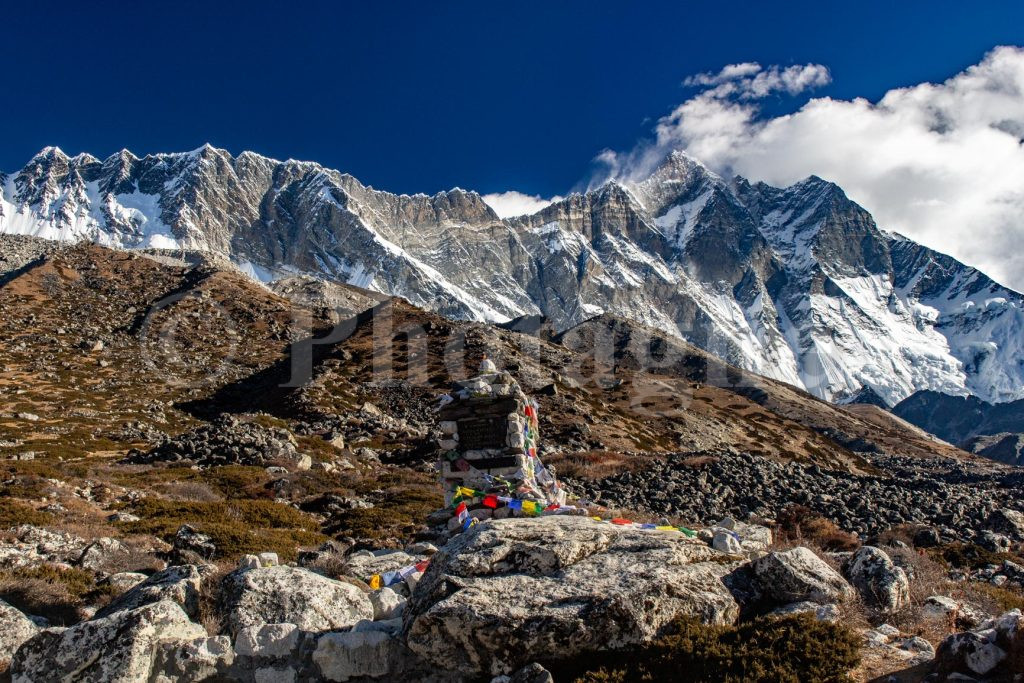
At the Yak Hostel in Dingboche, I spend the afternoon under the duvet, I'm really exhausted, it must be the effect of the altitude even if I haven't done much during the day. In the common room, I meet a Nepalese who loves France and a Colombian who walks at the same pace as me (5 days to get to Dingboche). He wants to try Island Peak. The meal is not good and expensive: it is a constant in Dingboche!
Ninth day. Chukhung Ri.
+ 1000m / – 600m 9km
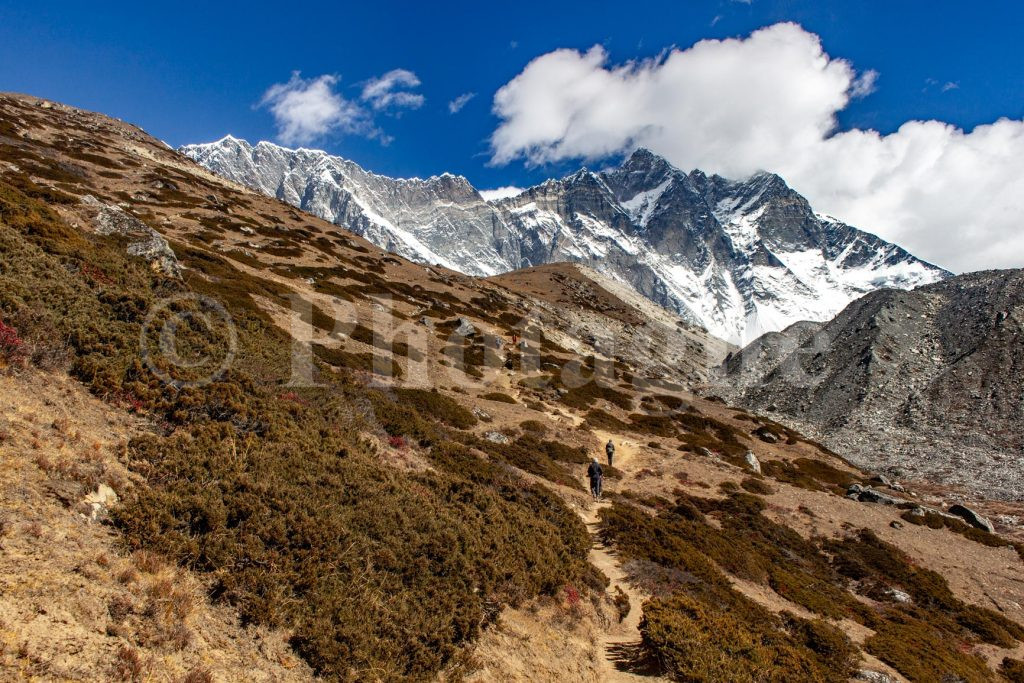
Breakfast of chapatis with butter… Rancid! I redo the way to Chukhung in the early morning, it is much better than the day before, I take advantage of the landscape this time. Honey pancake in Chukhung is much better! I leave for the Chukhung Ri in the middle of a few other groups of hikers. The path is very easy, surprisingly sandy at the start. I manage to find a steady pace that takes me almost to the pass at 5360m. Just before the pass, I still have this feeling of suffocation and the last meters are very difficult… I'm afraid I might faint again! But the pass is finally reached, the panorama is fantastic. Especially the Lhotse which completely dominates the scene. I take a few photos/videos with the friendly hikers who climbed with me, then I quickly descend. It's going so fast in the opposite direction...

Change of program
Well-deserved rest at the lodge. The next day, I ultimately don't think of doing the Kongma La (first pass of the three passes trek) but going through the valley: 5550m seems unattainable to me unless I take an extra day of acclimatization, and I don't want to to go around in circles in Chukhung... Besides, I don't even really enjoy going so high: the light is much too harsh, and the feeling of dragging myself like a slug is frankly unpleasant for me. The high mountains are sublime, but I discover that ultimately (once is not customary) I prefer the medium mountains: these first days before reaching Namche were so exotic! I have one more day due to my skipped acclimatization, I have several choices for the rest of the events:
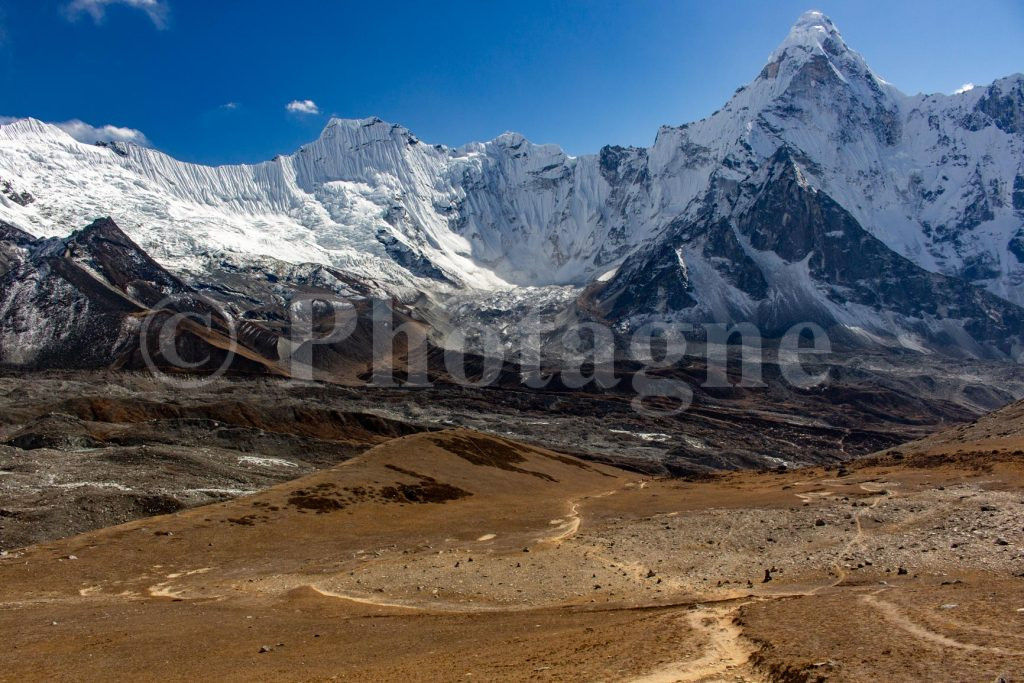
- Stay one more day in Chukhung to do the pass (meh)
- Go do the Kala Patthar and take a walk in the middle of all the people who want to see Everest up close (blah blah)
- Spend one more day in the middle mountains towards Salleri (yes!)
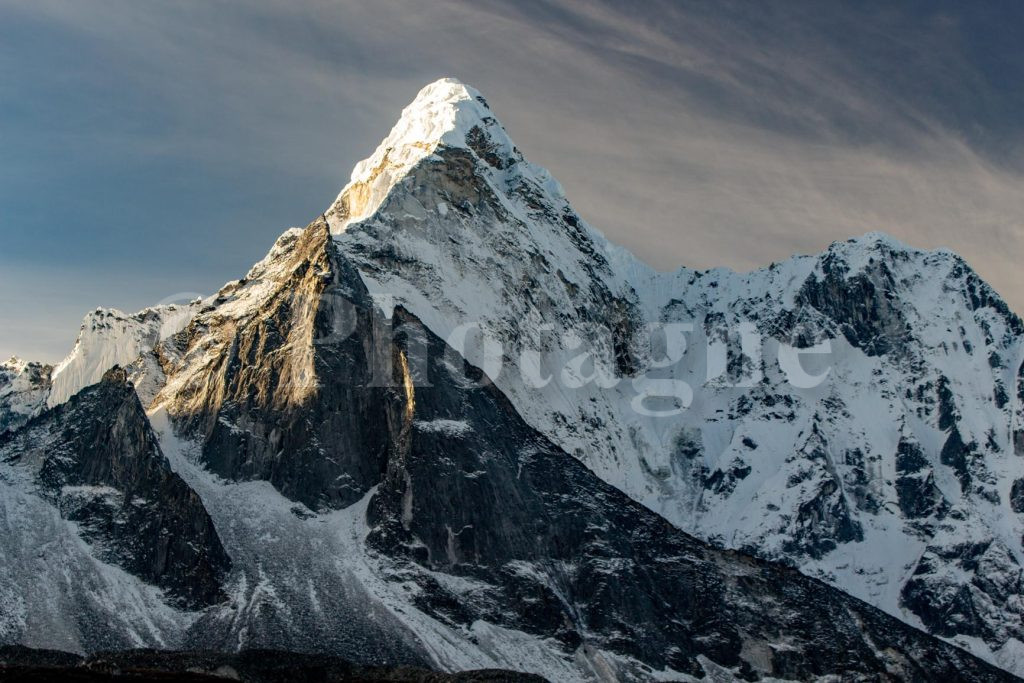
I therefore choose the third option. In the evening, the meal is not too expensive and rather good at the lodge at the end of the village.
Tenth day. The trek of the three passes is transformed into the trek of the two passes.
+ 800m / – 700m 18km
Walkabout on the way to Everest
Departure after a rather good cinnamon porridge. I have a fantastic view of Ama Dablam in the morning. I go back down to Dingboche then take the normal route to Everest base camp. It's horrible: I'm in the middle of endless lines of hikers. So, I don't really benefit. I take a really not very good sherpa stew at the bottom of the Khumbu moraine. I decide to take a short trip to Lobuche before going to Dzongla, at the foot of the Cho La pass (second pass of the three passes trek). The views are relatively pretty but they don't enchant me.
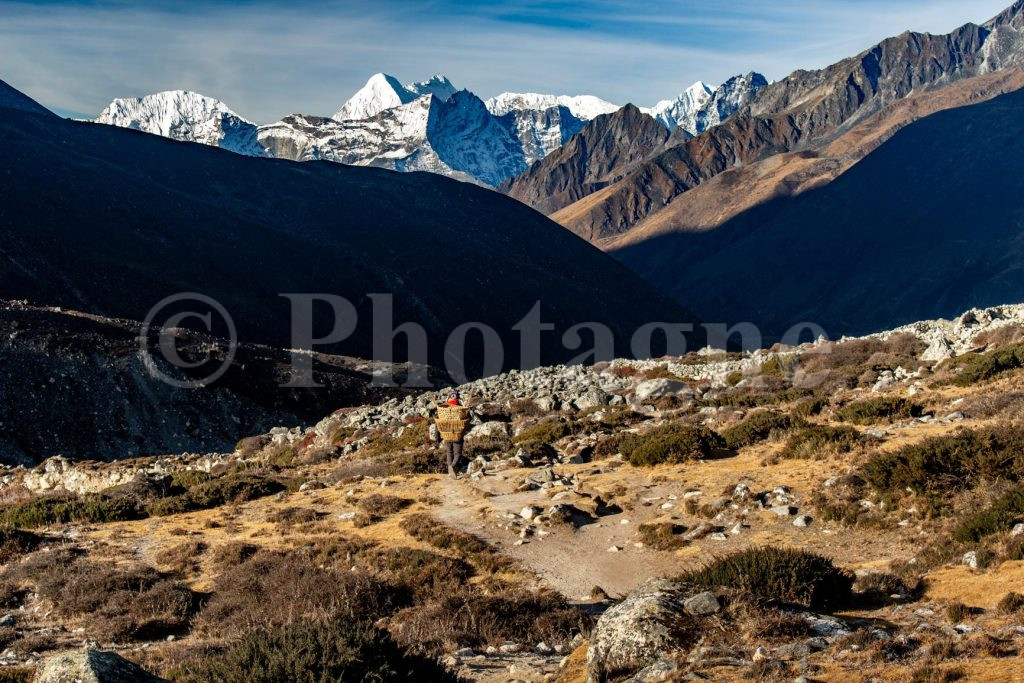
Return to a less populated mountain
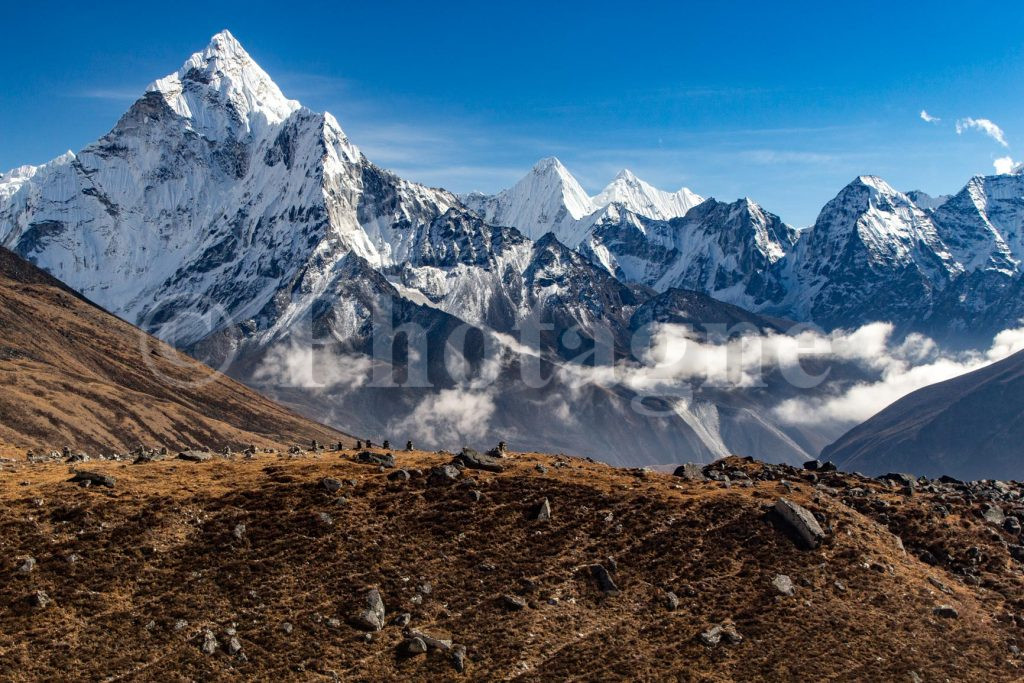
Everything changes when I leave the Everest base camp path to go towards Dzongla: I enjoy superb views of the Dingboche valley and Ama Dablam in the background. After a bend, suddenly there is an unforgettable view of the more than 1000m of vertical wall of the Cholatse and the glacial lake at its foot. It's great, there is no one left, and the mountain is also greener, less rocky. The light is incredibly harsh, the sun blinds and the shadow is pitch black. I bought sunglasses because mine broke, I couldn't survive without them. In the evening a little mist rises, it's sublime with this intense sun, a world in black and white.
I end up with a small ascent which hurts at the end of the day at 4800m before the refuge. I meet an Indian who knows nothing about trekking (he manages a trekking site!) and a very friendly German. The latter really traveled all over the world for his work, it's crazy! The refuge is very expensive on the other hand, 850NPR the Dahl Bat.
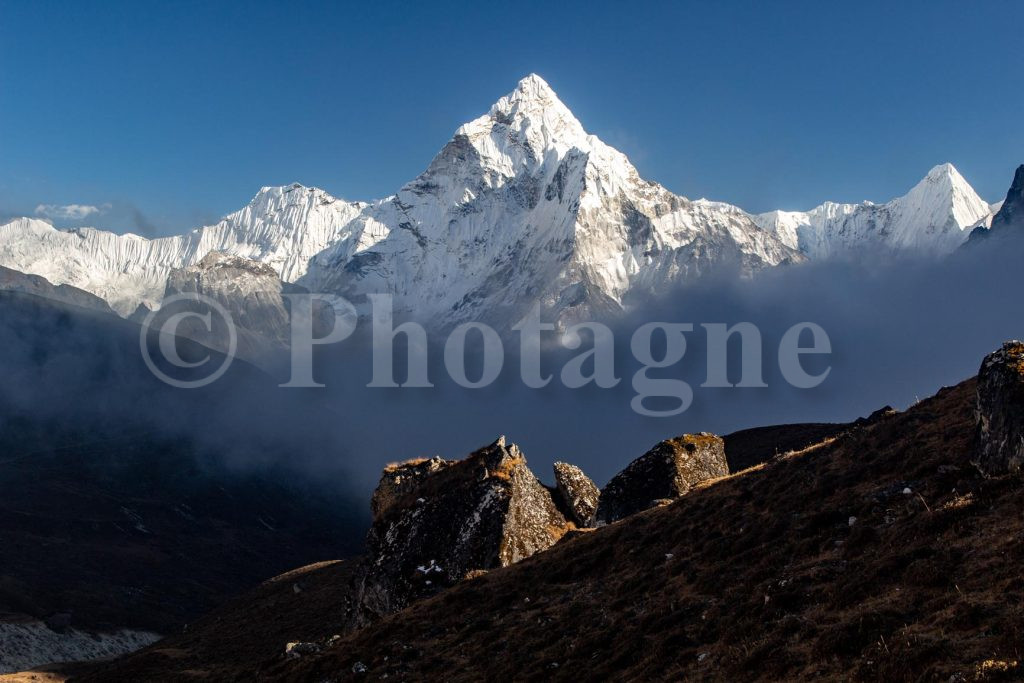

The three passes trek solo. Part three: Gokyo.
Eleventh day. Ngozumpa glacier.
+ 800m / – 900m 12km
The Cho La pass and its glacier
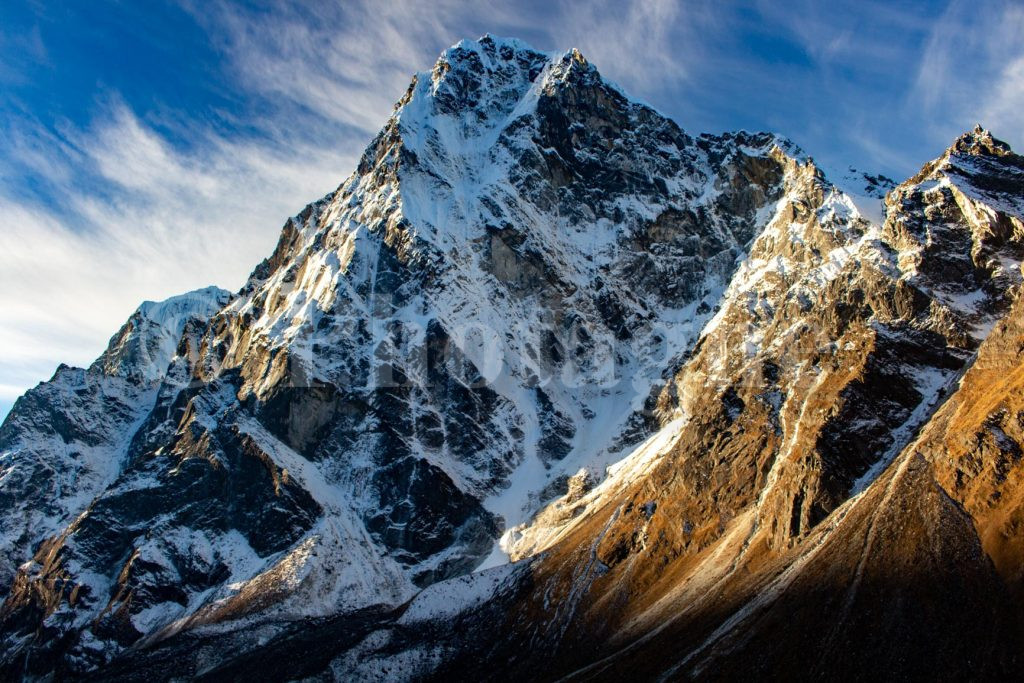
Departure at 6:30 a.m., there is an incredible rising sun over the Cholatse. The water froze in my canteens at night, luckily the blankets are thick. I pass a few valleys with alpine airs then the hard climb begins. I'm still running out of breath, people are catching up with me. The landscape becomes very mineral. We arrive at the foot of the glacier that we have to cross, I'm happy to have my mini-crampons, the start is steep on ice. Finally, it's almost easier on the glacier because I can have a regular rhythm.
The moraine
Arriving at the second pass of the three passes trek, there are lots of people and the view is not extraordinary unfortunately… But I still really liked this climb. The descent is initially steep then it is a long, uninteresting passage through grassland. Not very good vegetable soup in Dragnag. Then it's the crossing of the Ngozumpa glacier and there it is quite simply the most impressive section of the entire route of the three passes trek: it is an immense river of stones, a real labyrinth where lakes are hidden behind mountains of stones. Rocks are constantly falling as the ice melts. And all this comes from Cho Oyu, which is so far on the horizon...
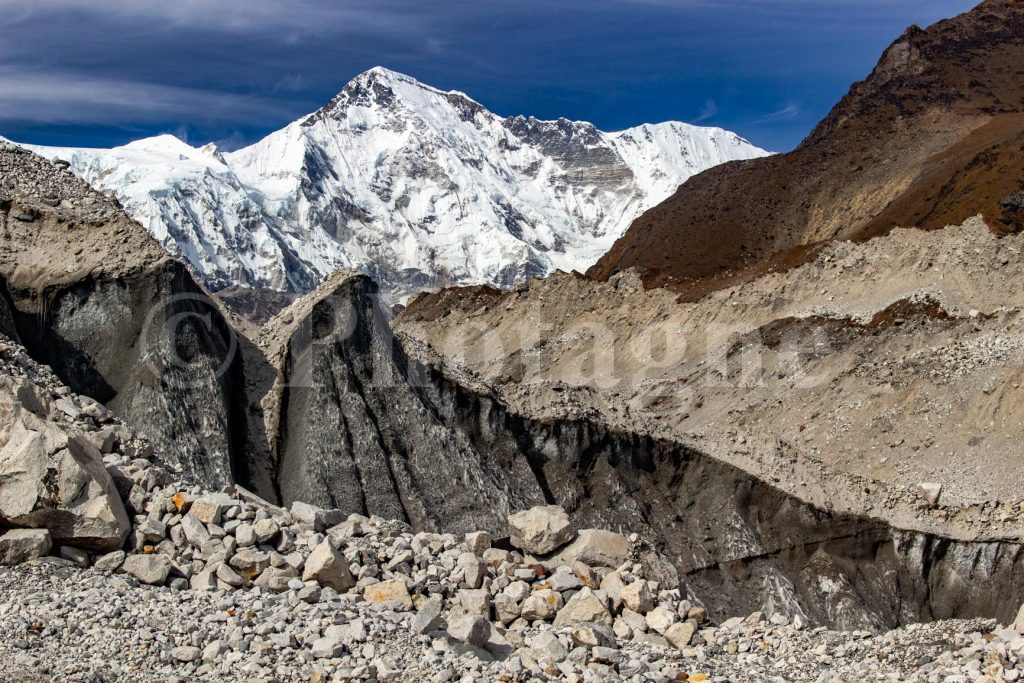

Arrival on Gokyo
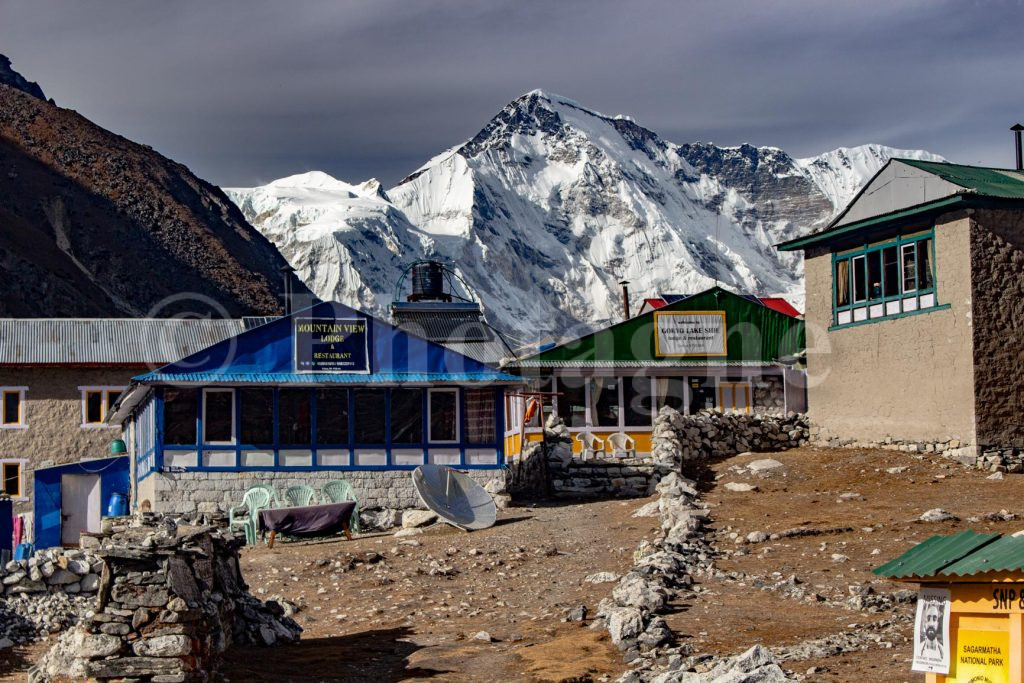
Fortunately, the path is well marked and avoids places where stones roll. After this long and exhausting moraine crossing, I arrive at Gokyo. No one lied to me: this is one of the most beautiful places on the course. The lake is one color… I'm staying in a “fancy” multi-storey building, the room is only 200 NPR. But I understand why when I see the menu: the Dahl Bat is 900NPR! But this one is excellent, and they also do some killer desserts, including a blueberry brioche that sends heavy.
Twelfth day. Exploring Gokyo.
+ 800m / – 800m 15km
I stay in Gokyo one more day to visit the area, staying in the same lodge because the food is very good there despite the high price. Gokyo Ri climb in the morning: I'm much less out of breath than before, it's crazy, now I can maintain a better pace uphill. At the summit, it is the most sublime panorama of the three passes trek. Cho Oyu, Everest, Lhotse, Makalu, the immense moraine and the lake, not to mention countless other peaks: it's fantastic. But it’s freezing cold…
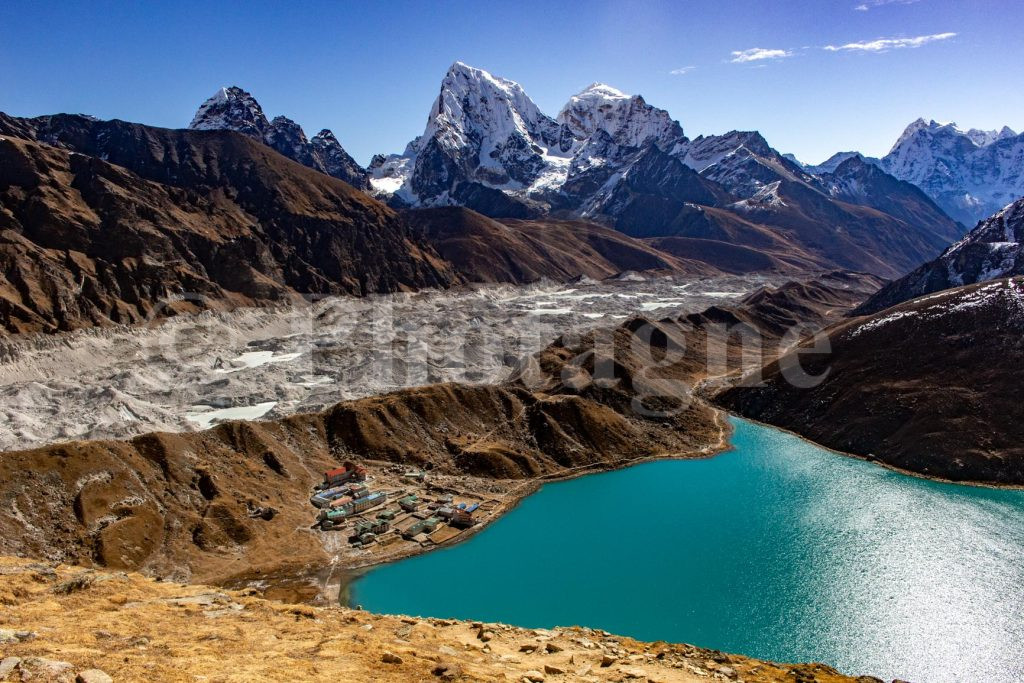

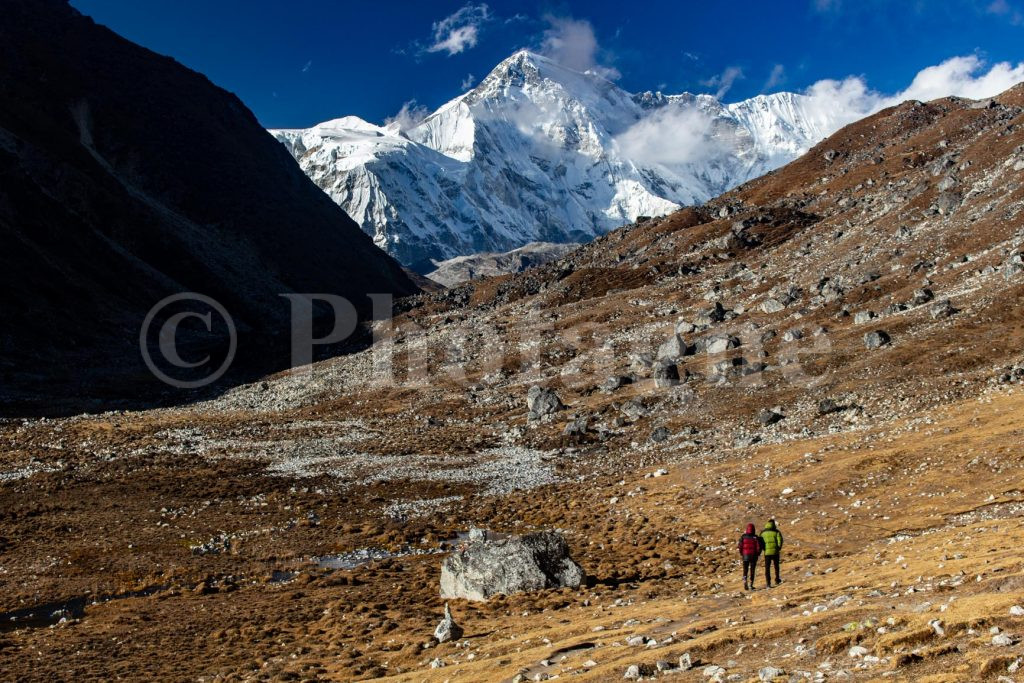
I go back down in less than an hour, eat a delicious Sherpa stew, and leave to visit the lakes further up the valley. It's a fairly quiet hike that follows the moraine, there's hardly anyone around. I arrive at the second lake, the feeling of “paumitude” is total, it is empty and immense. Nice views of the Cho Oyu on the way back. The next day I will pass the Renjo La and that will be the end of my stay at altitude: all I have to do is go down to Salleri and take the jeep! I have to say I won't be unhappy to come back down, hiking at altitude is way more strenuous than I expected. As a result, my stages are short (this can be seen clearly on the GPX!) and I'm chomping at the bit.
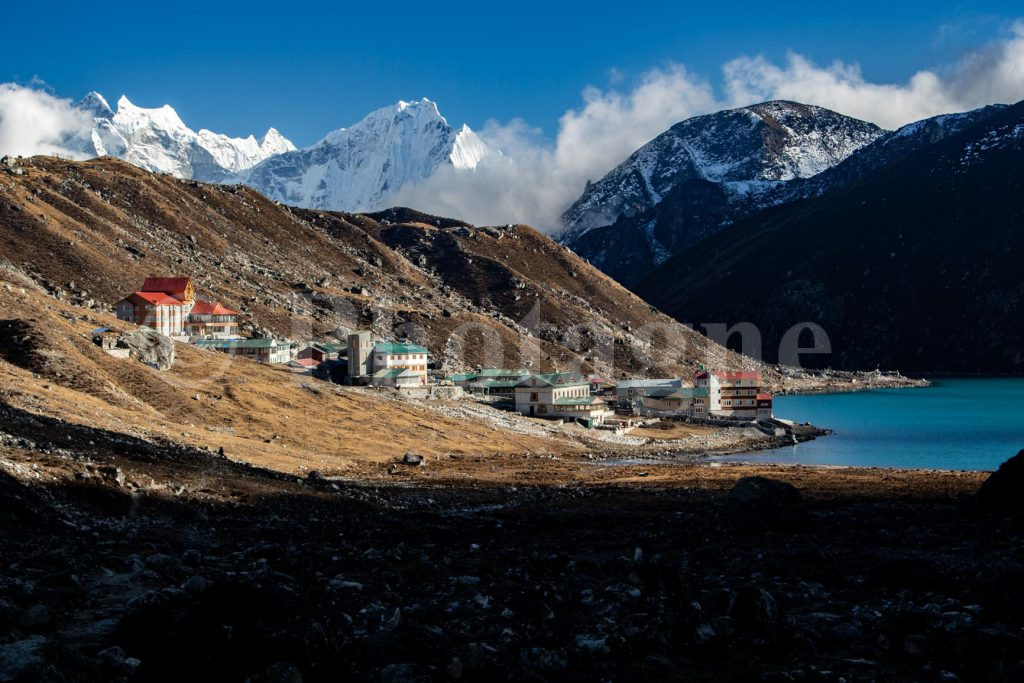
Thirteenth day. Change of atmosphere.
+ 750m / – 2050m 23km
The Renjo La pass
Departure at 6:30 am for the third pass of the three passes trek. It was less cold in the rooms at Gokyo than elsewhere for the same altitude, the lake must temper the climate a little. The start of the climb is very cool and little by little a beautiful view of Everest is revealed. The second part of the climb is steeper and harder… Nothing to do, I don't take pleasure in climbing in this rarefied air with the impression that nothing is going into my lungs. Not sure that I will return one day to these altitudes, or else I will have to spend a lot more time there to acclimatize.
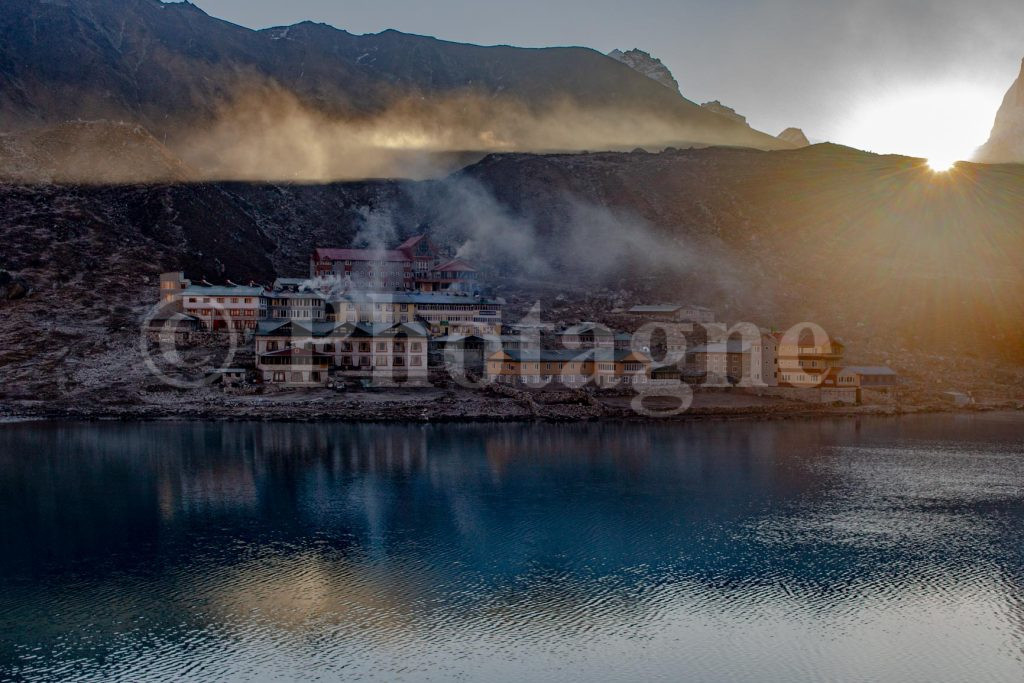
Farewell to Everest...
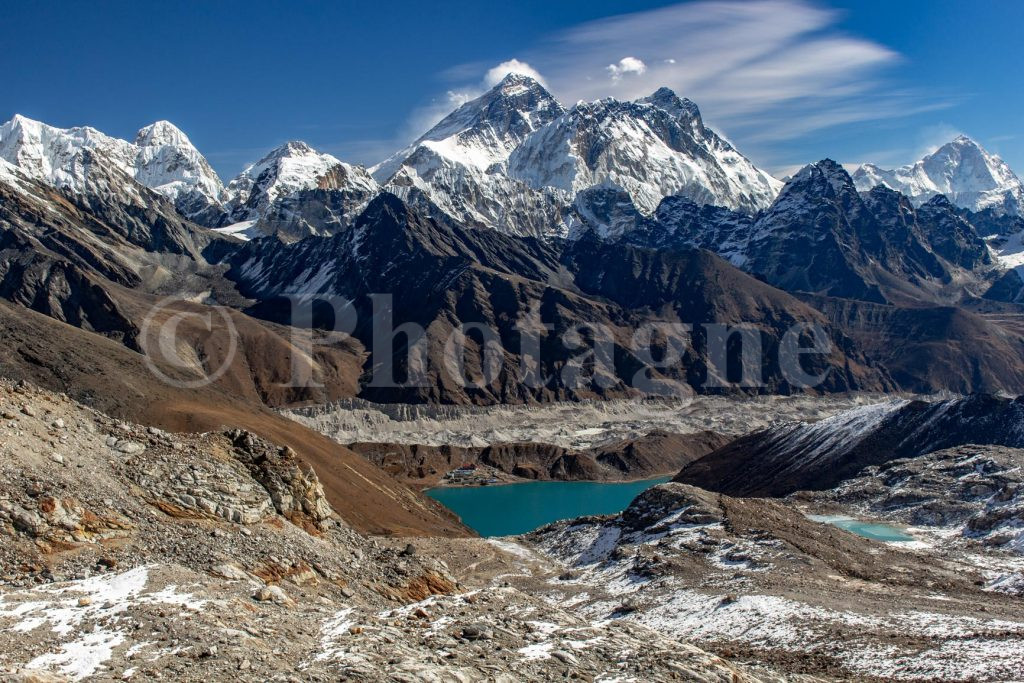
The Renjo La is finally reached, sumptuous view of Gokyo and the 8000m. This is the opportunity to say a final farewell to them… Fast and pleasant descent in a landscape that could recall the Alps, with glacial lakes. I eat a Sherpa stew in the first village crossed, then descend gradually into this immense valley which leads from Nepal to Tibet. It's incredible: past 2 p.m., I don't really come across any hiker.
Back to warmer skies
A few clouds accumulate and I happily find a sky of lower altitude, more humid and which filters the sunlight better. No more feeling of being in space! Very beautiful lights at the end of the afternoon. I pass Thame, a very beautiful village on a terrace surrounded by torrents, then an impressive gorge. It's evening and I find the place just superb: a small juniper forest on very steep slopes with snow-capped peaks that can be glimpsed from time to time in the mist. It's very quiet, we hear some birdsong. I feel like I'm coming back to life, I definitely prefer medium to high mountains.
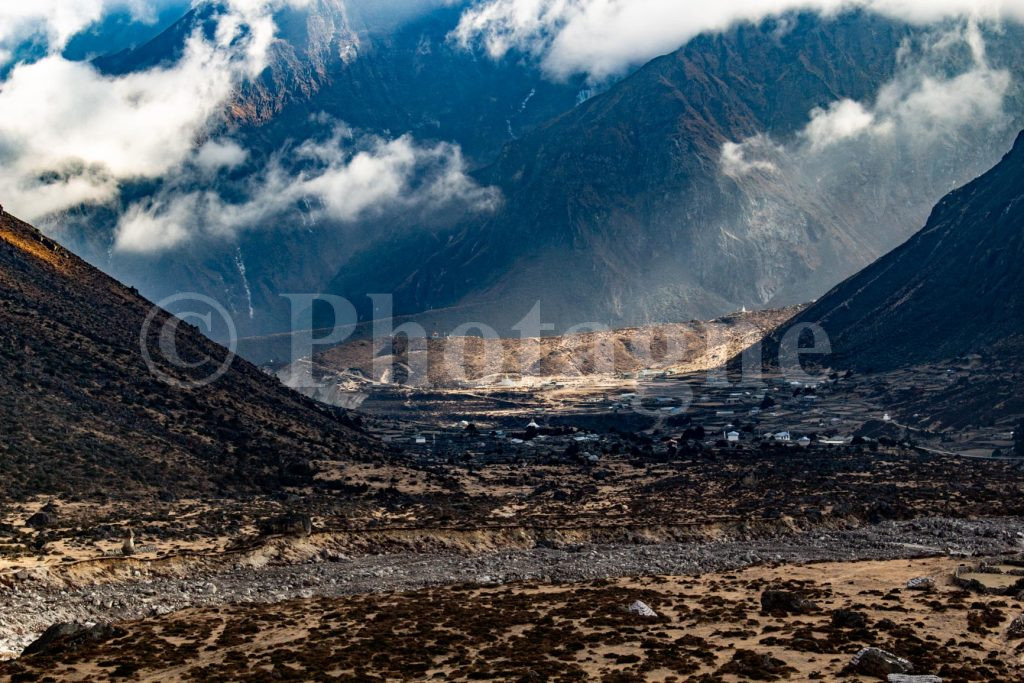
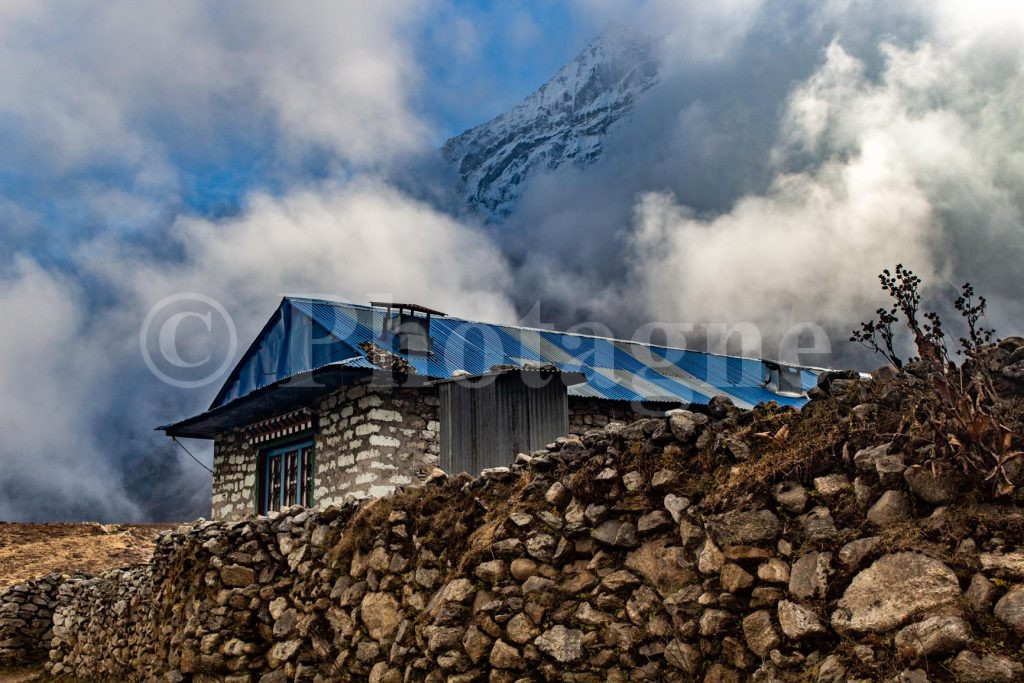
In a village, a huge “Whooof” made me jump: it was a monal that flew past just above my head! I see others further in the forest. I end up stopping at a guesthouse in Thamo, a little before Namche. It is without comparison the most comfortable place of my stay: solid and well insulated house which does not give the impression of wanting to collapse at the first jolt, ultra-clean room and toilets, electricity and running water, 3G . The atmosphere is nice and more, I chat with Nepalese who are also trekking.
The trek of the three passes. Part Four: From Namche to Jiri.
Fourteenth day. A so-called descent.
+ 850m / – 1700m 21km
Namche in the morning
I leave before the sun reaches the guesthouse, it's still cold, the ground is frozen. It's very beautiful, I admire a landscape of forest between magnolias and conifers. No monal this time but I think I hear some in the distance. All this beautiful mossy forest revives me. Then suddenly I arrive above Namche: how beautiful is this town clinging to its high valley! I visit a temple and eat a cinnamon roll in a cozy tourist cafe (prices go with it). Then it's the steep descent after Namche, and finally you have to follow in the other direction all the route that I have already done in this immense valley.
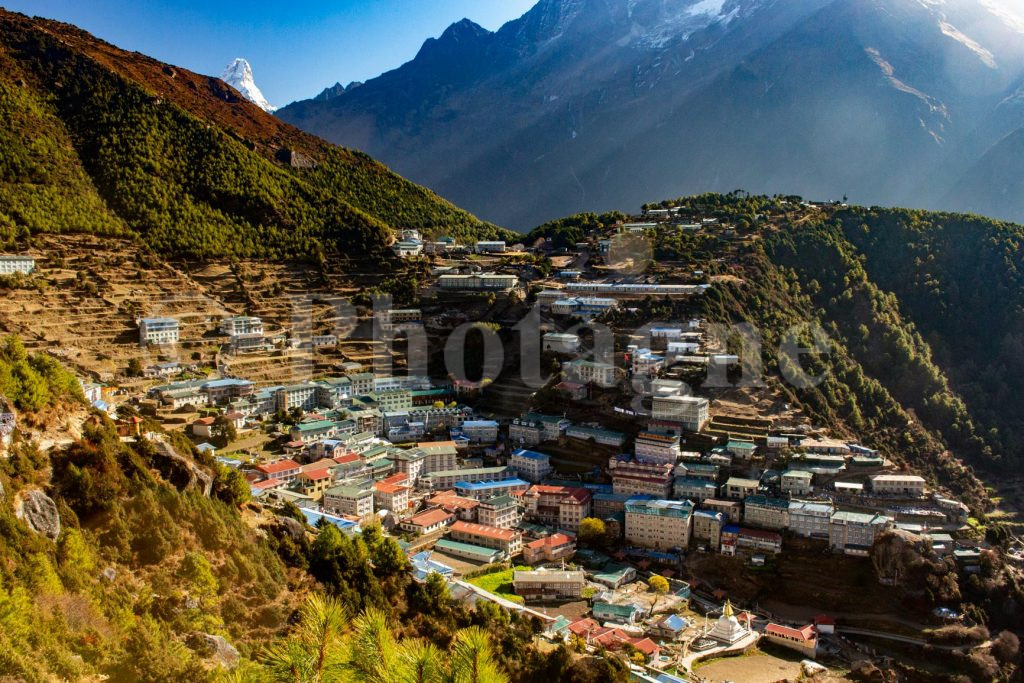
Chaurikharka's grandmother
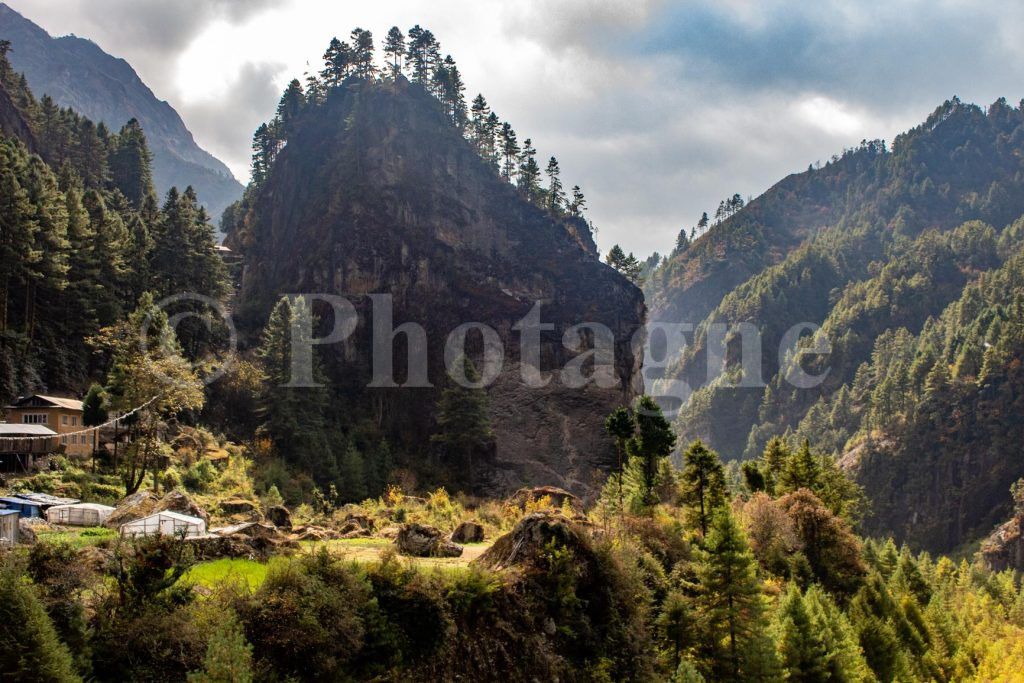
I naively thought I would have an easy day downhill. However, I had forgotten that this part of the route was only a succession of climbs and descents! I ask myself a few moments to eat a guava and a pear. I had forgotten how good fruit can be… The day is getting long and I have a mild cold which doesn't help matters: I'm exhausted. I decide to stop quite early at the grandmother's where I had eaten the best Dahl beats of the course on the way out. It's really authentic: the grandmother speaks 3 words of English, she laughs a little all the time, I help her put the blankets on and then I watch her take care of the fresh milk from the milking. From my room, I hear him humming Buddhist mantras. Surprisingly I am not alone, a Mongolian trekker stopped. Dahl Bat still good, with coriander.
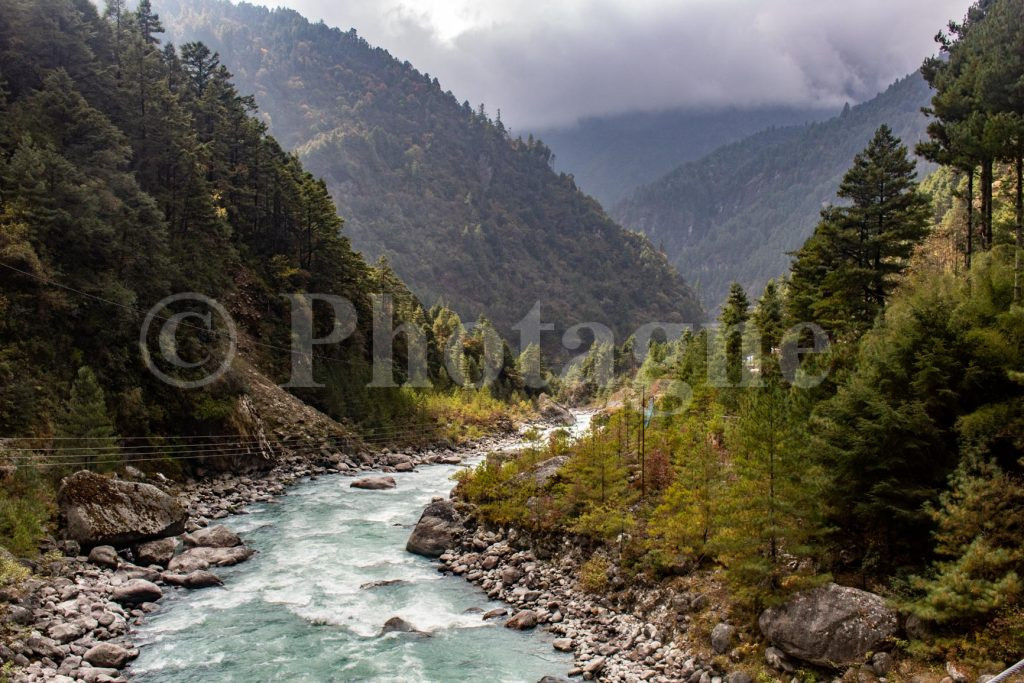
Fifteenth day. Competition Momos.
+ 1300m / – 1850m 17km
Unpleasant cold
Departure after a very good pancake and some photos with the grandmother. In addition the whole thing only costs me 1200NPR, a gift. The trail descends easily at first but then there is a big 500m climb that I was not expecting (going down the valley, you know!). My cold is in full swing and I drag myself like a slug, blowing my nose every 5 minutes. Finally arrived in the sun, I stop for a long time without thinking of anything. Then I stop again shortly after in a small restaurant. Very good choice: it takes an hour to prepare my order, but how good is it! Potatoes sautéed with a fried egg, a slaughter, then the freshly made Momos, to die for. The dough itself has a pretty strong flour taste that I won't find anywhere else.
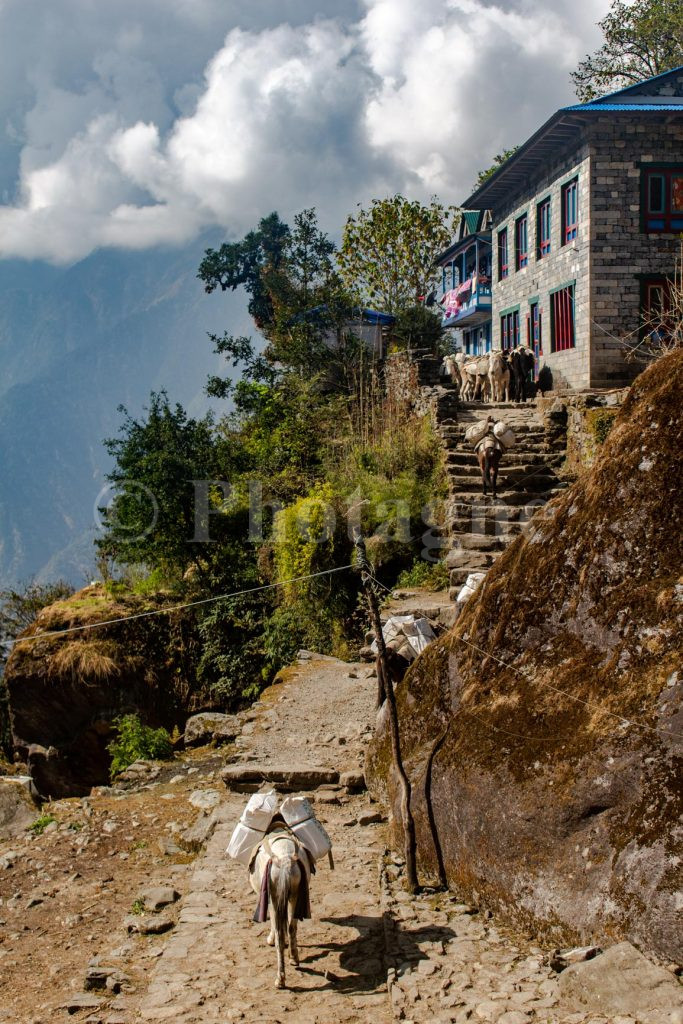
The afternoon begins with a not obvious section of path, in the shade and made up only of slippery stones of mud and donkey poo… I come across endless caravans of donkeys. It is a relief to finally descend to the pretty village of Kharikola. I rediscover with pleasure the greenery, the flowers, the crops on the terrace, the neat gardens and the beautiful houses: how pleasing to the eye!
An English traveler
I stop in a very beautiful and comfortable lodge in the village, there is even electricity in the room. I take a hot shower because for the first time on the course we don't curdle too much in the evening, what a luxury! This does not prevent me from enjoying my lemon ginger tea.
The Dahl Bat is ok and I chat with friendly English, yet another long-haul traveler. He introduces me to local alcohol, made with millet and served hot: it quickly goes to my head and it's not famous... He is doing this trek for the n-th time. Hard to understand why so many people keep going back to this hike again and again. Ok, it is very beautiful, but the world is so big… Why not explore other lesser known places in Nepal instead? If I ever come back to this country, that will be my goal.
Sixteenth day. Ahead of the program.
+ 2400m / – 1800m 23km
Direct ascent
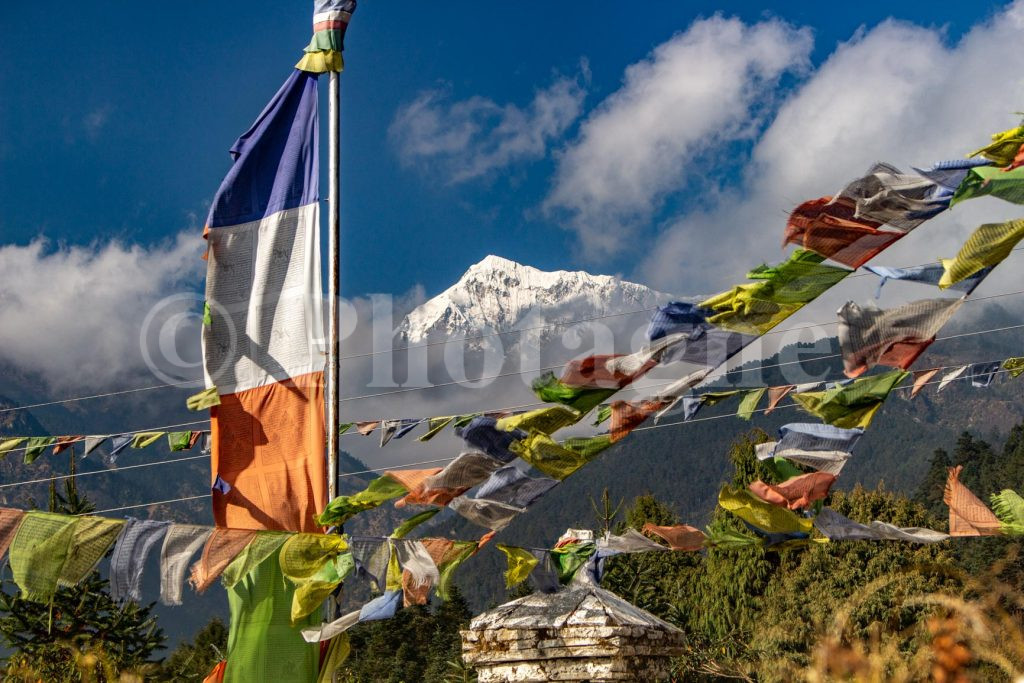
I start with a descent in the middle of this landscape which is definitely my favorite of the course of the trek of the three passes. In addition here everyone is smiling, it really looks like a lost and idyllic valley. Once I've crossed the Dudh Koshi at the bottom of the valley, a 1500m ascent awaits me and it gets long at the end… I stop at the first restaurant in Taksindu, completely exhausted. Double portion of grilled egg potatoes with a little cat on the lap. The potatoes are almost not cooked, too bad. Leaving the restaurant, I cross the pass and retrace my steps from the very beginning of the hike: it's a moment that seems so far away...
An idyllic place
I have 2 more days on my program and I tell myself that I have time to continue until the next city, Jiri. It will give me more mid-mountain, flowers, delicious and inexpensive food, too good! So I continue to Phurteng. It's 4:15 p.m., the sun is setting, the place has a superb view, is absolutely peaceful, and a cat is making eyes at me...
I strongly hesitate to stop at the local hostel, but if I have to continue to Jiri I have to cover miles. So I decide to continue to Junbesi, which I join in the evening mist when everything is turning gray. Very nice course in large meadows, quite a few animals on the way, in particular a local fallow deer with its white behind. The lodge is made of wood, it looks like a Savoyard chalet. I come across two French people who are hiking in the middle of the mountains without going to the Everest valley, I almost want to kiss them! Delicious Momo and breakfast too but I pay all of that an inconceivable price for this portion of the course, 2500NPR.
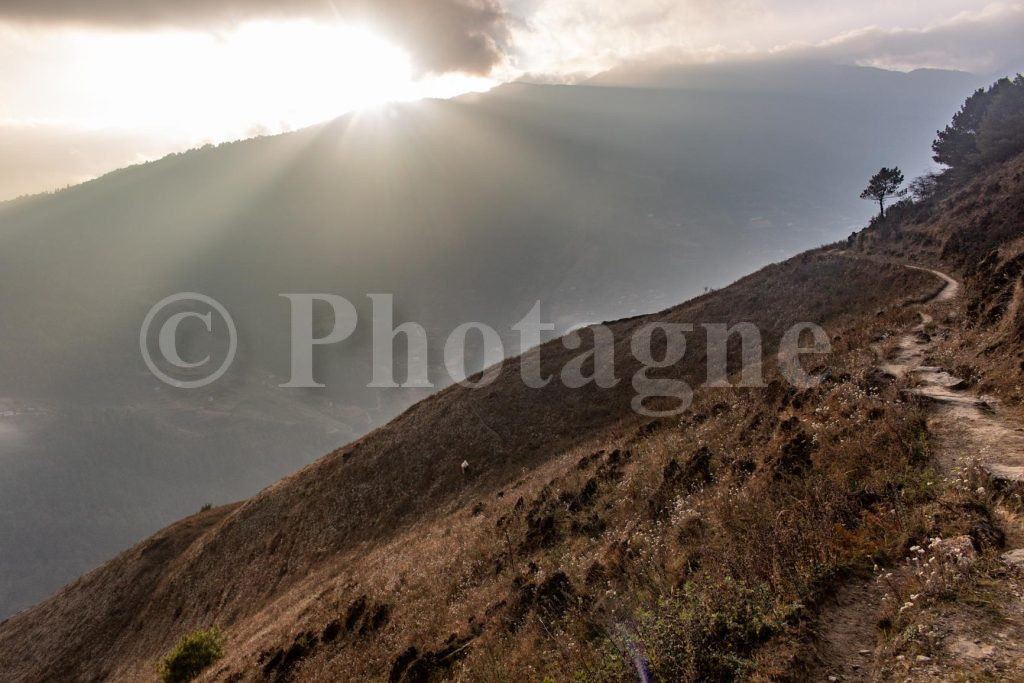
Seventeenth day. Back to civilization… and its roads.
+ 1850m / – 2300m 24km
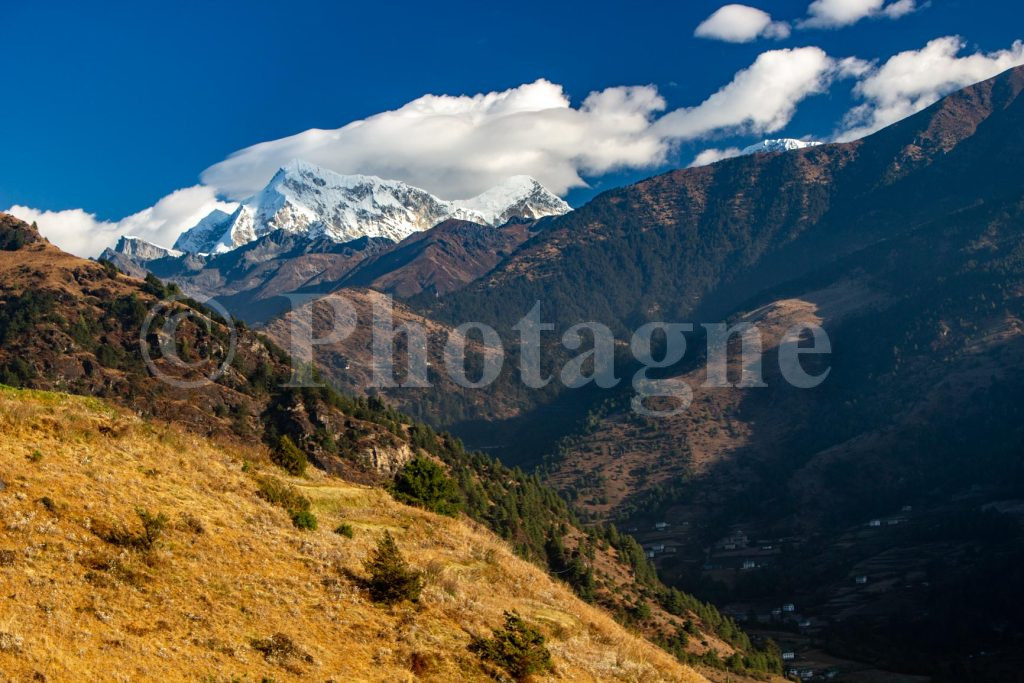
I start with a 900m climb to the pass. It's rural and pretty, but less exotic than before: you might think you're in a valley in the Alps, apart from the houses and the people (ok, there are also the rhododendrons). Then the climb becomes painful because they traced a track which completely destroyed the path. All of this puts me in a bad mood...
An unknown animal
On the descent, things get better: even if the panorama isn't crazy, the path becomes again for pedestrians only and the more I go down, the prettier it is. I see in the trees an animal that looks like a huge squirrel in black and white. No matter how much I searched the Internet for what it could be, I couldn't find anything (if you know, don't hesitate to comment at the bottom of the article!). Very good fried potatoes and omelet, and I was served a real lemon tea (tea + lemon), not one of those Lipton craps like I had too often on the upper part of the course.
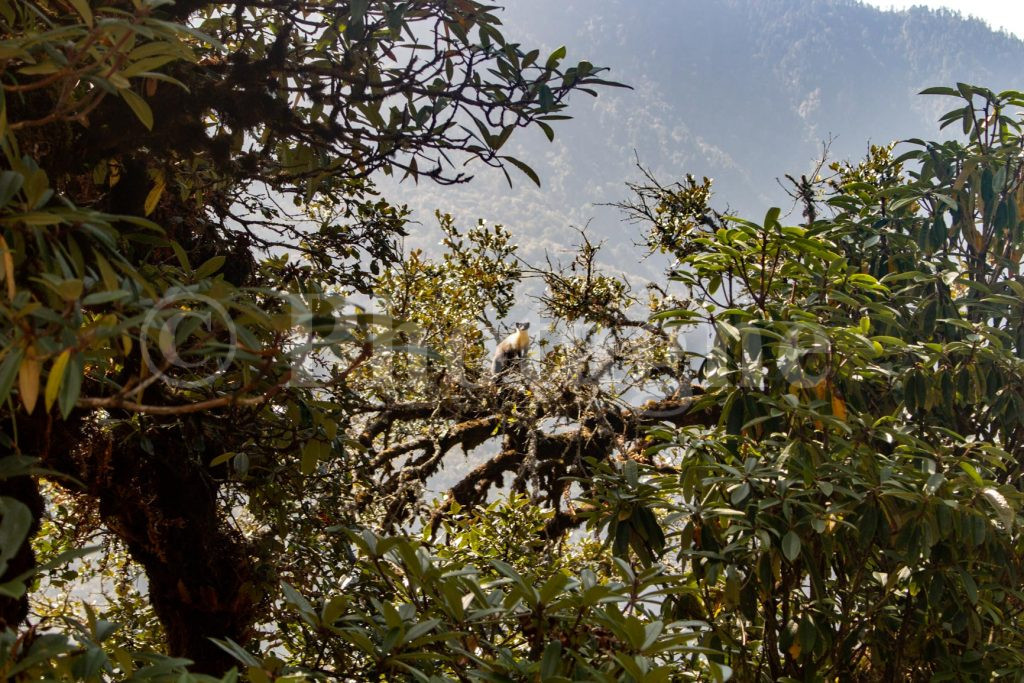
Kinja
It's warmer as I descend another 1000m and the atmosphere becomes tropical again. It's very pretty and lively, there's a school, the Nepalese live in the fields, weave the wicker, take care of the cows or the goats. Kinja is really a very pretty village but if I want to go to Jiri I have to continue once again. What was a path on the guide has become a road: too bad. Altogether this extra portion up to Jiri has far too many roads and tracks for my taste. And not one of the many people I asked if the trek to Jiri was worth it could tell me about that…
Nepalese villages at night
I let a Jeep pass and I regret it, I should have hitchhiked. At the end, there is still a damn beautiful panorama and pretty waterfalls. I'm on the wrong path (now that we're closer to civilization there are paths everywhere and it's easy to get lost). I find myself on another track and it's very lively in the evening, there are schoolchildren returning home, people passing by on foot or on motorbikes, all the children say “Namasté” to me. Tonight, I really feel like a stranger even more, everyone is looking at me, probably because I'm the only hiker at that time.
An authentic lodge
I stop at a lodge in Bandhar that is decidedly more “authentic” than “touristy”. It will be Dahl Bat, too bad, I would have taken back Momos. The Nepalese always leave the door open, what the hell! While waiting for the meal, I help the little girl, who must not be more than 5 years old, with her homework in English. She already knows how to speak a few sentences, in this lost corner in the middle of nowhere, it's incredible!
The meal proves to me that it is definitely an authentic place: the Dahl Bat is monstrously spicy, I characterize it with a single word: SUFFERING. EVERYTHING is spicy, the dahl the veggies and even the fucking rice I was trying to put out the fire with at first not understanding why it didn't work.
Eighteenth day. End of the trek of the three passes and arrival in Jiri.
+ 1300m / – 1500m 16km
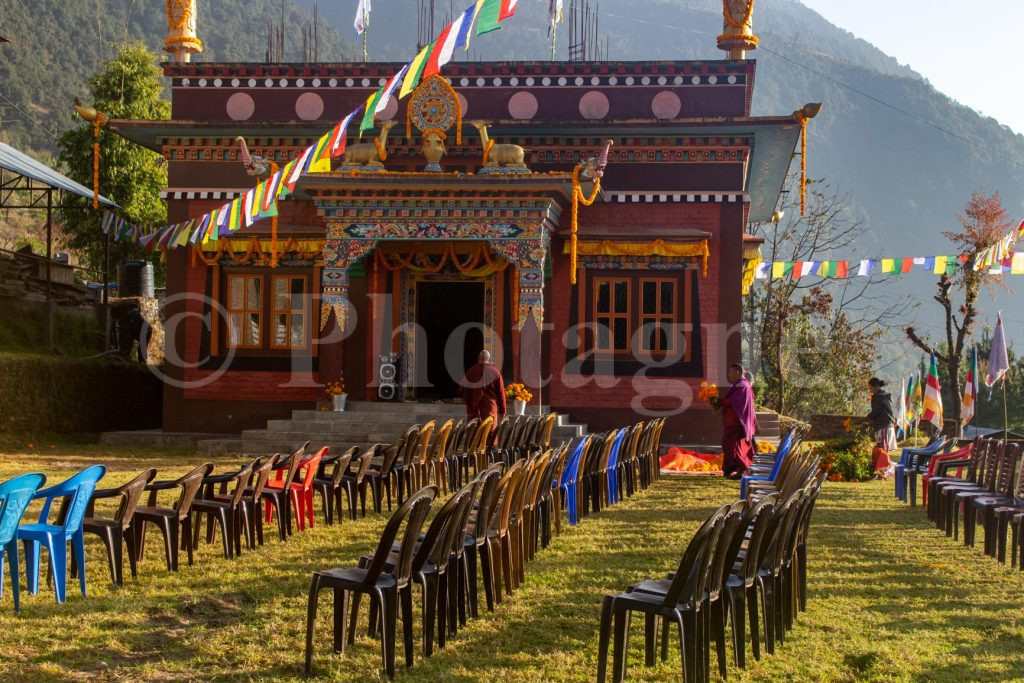
Breakfast consists of Tibetan bread and omelette, it's not very good, it smells very strongly of oil and doesn't even crisp. Everything was “authentic” in this place except the price, 2000NPR! Abusive for this section of the three passes trek. It was still fun sleeping upstairs with the whole family in the same hallway (grandparents and grandchildren). In addition, in the morning, we hear the haunting and repetitive music from the temple next door.
Last day of walking, already! But I don't dwell too much on my thoughts since I live in the moment on this trek. In the valley, a bus comes up at the same time as me and honks like an organ, you can hear it for miles. It's hot, I take off the legs of my pants for the first time since the beginning of the course. I pass a peaceful pass village then it's a pretty descent to Shivalaya. The path is less and less big, the countryside more inhabited, there are more roads/tracks. At school, all the kids tell me “Namaste! with great enthusiasm.
Shivalaya and its pretty valley
I buy 3 tangerines in Shivalaya (50NPR, that's what I thought, it's downright rip off at the lodges) and I continue. Very very pretty part then, along a torrent, it is inhabited everywhere as usual. People smile, talk a lot, ask me where I'm from and what I've done. A so-called journalist takes some pictures of me with my address. I then go back down to Jiri in a green countryside full of cherry blossoms that could make you think of the Vosges. In Jiri, I come across the first concrete road of the route.
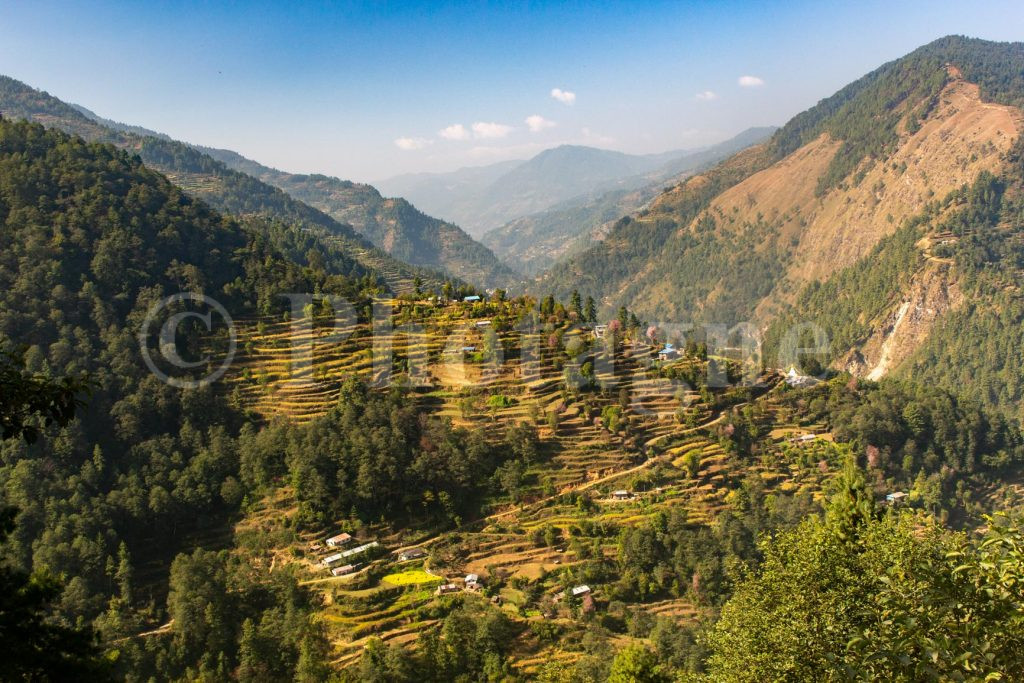
Impressions of Jiri
I stop in a hotel of inconceivable luxury (private bathroom with hot shower), eat an excellent samosa as well as a dish of Momos with beef next to a French, it's the first time that I eat meat in this country. Considering how quickly they arrived, they had to be prepared or frozen but they are still delicious. French warned me: there is nothing to do in this city. I hadn't believed him but after turning into the main street, it is clear that he was right. There are plenty of bazaars but they only sell things for locals: big baskets, pots, backpacks for kids… Not much for tourists.
Looking for a bus
I see girls wearing suits and ties, probably for school. I ask several people for the bus schedules and I am told that it must leave between 6am and 8am, without further details. Apparently no set schedule. I look at the place of the buses and I understand why: people crowd into pickups leaving God knows where, at 10 in the trunk and so much in the back seat that the door no longer closes.
A hotel manager ends up booking a bus for me at 7am. I buy myself very acidic kiwis which burn my tongue and peanuts. I inquire about a strange fruit that I had already seen grow on trees, apparently it is a kind of tomato that is served in pickles. Maybe I tasted it the night before in this too spicy dish, it had a vague taste of artichoke. After a dish of Chowmein to die for filled with fresh vegetables, I have to face the facts: everything is also homemade in this hotel, and it's simply delicious for a ridiculous price. Top !
Nineteenth and twentieth days. Return trip.
Bus to Kathmandu
I have breakfast with the guy who booked the bus: as I misunderstood the time, I drag him and his wife out of bed at 6:30, poor things. This does not prevent them from making me a very thick and delicious pancake. I take the bus around 7:20 am, it is small, there are about ten of us. I am impressed that there is a paved road at the start, and it seems to be in good condition. On the guide we can read that it was built by a Swiss aid project.
But we quickly find these good old tracks completely rutted. The bus jumps so much that sometimes I take off from my seat, luckily the ceiling is high. At the first stop, I buy oranges and bananas. Instead of understanding 3 oranges, the saleswoman understands 3 kg, I have a monstrous quantity. They are very good but very acidic. I chat on the bus with an engineer and a student in materials physics! It passes the time well. The view is pretty but not as beautiful as on the way there. Arrived in Kathmandu, I get tricked into paying 1200NPR per night in a hotel.
Kathmandu and its incredible energy
I visit Kathmandu and there I fall in love. As much as the first day in this city did not please me so much because everyone fell on my saddle to sell me one thing or the other, once I got used to this aspect I no longer felt it too much and I loved the city. It's so teeming with life and energy that I don't know where to turn. The tiny streets are crowded with scooters and pedestrians of all kinds. There are sellers of everything: bazaars, spices, yoghurts with dried fruits, musical instruments, crisps (!)… Side by side you can find motorcycle batteries, underpants, incense, televisions and still everything a lot of things that I can't identify. There are shops so small that the seller sits on a chair in the middle and can reach everything by stretching out his arms.
I buy heaps of souvenirs and surely get ripped off: scarves, spices, teas, various trinkets… I eat Momos in a place that does just that in a big pot, 100NPR for 10 Momos. Too spicy, of course, and again this is the soft version. Dessert: a kind of marzipan with spices, which is really not crazy. The next day again, a few more races, I visit Durbar Square and its many temples, and it's already time to return. I live my last misadventure at Dubai airport, where unsuspectingly I change my remaining rupees into euros and lose 30 euros in the case of unfavorable exchange rates. But what a journey!
Conclusion: my price distribution for the three passes trek solo.
- Best Dahl Bat: that of the grandmother near Lukla
- Best Momos: in Paiya the day I had a cold
- Most impressive passage: the moraine crossing in Gokyo
- Best vantage point: Gokyo Ri
- Most beautiful mountain:Ama Dablam
- Nicest person: the indian who knew anything about trekking in Dzongla
If you liked the landscape photographs on this page, please take a look at the section Pictures. For example, you can order a mountain poster of my photos, which is a good way to support me ;).






































































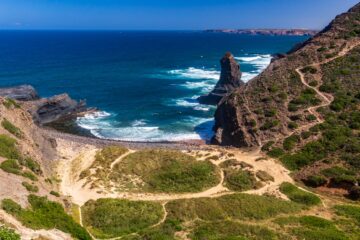
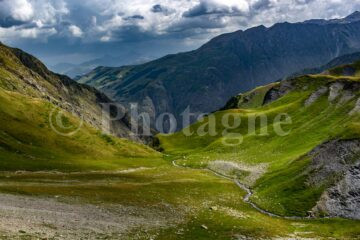
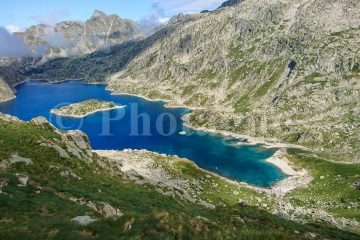
0 Comments